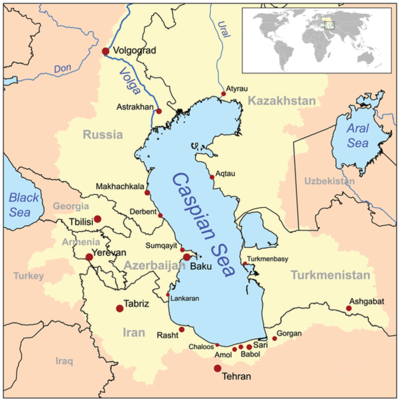"Ram Sarup Joon (History of the Jats/Chapter VI, p.115)writes that Dr. Huthi of Georgia paid a visit to India in 1967 and studied the Gujars living in Northern India. He has stated that there are Georgian tribes too among the Gujars because the accent of the Indian Gujars, their dress and their bullock carts resemble that of the Georgians. Dr. Huthi is of the view that they came to India when Timur let loose a reign of terror over them and consequently they settled here. They came here to protect their lives and religion and called themselves "Georgian", "Jorjars",. Later this word was changed into Gujjar..."Georgia" is an exonym, used in the West since the medieval period. It is presumably derived from the Persian designation of the Georgians, gurğ, ğurğ, borrowed around the time of the First Crusade, ultimately derived from the Middle Persian varkâna, meaning "land of Varkas"...Early modern authors such as Jean Chardin tried to link the name to the literal meaning of Greek γεωργός ("tiller of the earth; agriculturalist")."
Who were the Gurjara-Pratīhāras?
V. B. Mishra
Annals of the Bhandarkar Oriental Research Institute Vol. 35, No. 1/4 (1954), pp. 42-53 (12 pages)
A rebuttal of Shanta Rani sharmas arguments-and of hersupporters
Posted on November 18, 2015 by gurjaradesa
Shanta Rani Sharma published an article named “Explodingthe Myth of the Gūjara Identity of the Imperial Pratihāras“. In this article she mentions the Gallaka inscription which states that Nagabhata I defeated the “invincible Gurjaras”. Naghabhatta I was the first king of the Imperial Pratihara dynasty, Shanta Rani implies that Gallaka’s inscription is conclusive and unambiguous evidence that Pratiharas were not Gurjaras.
She further asserts that Pratiharas such as Mathanadeva and Hariraja were known as Gurjaras because of their nationality not ethnicity; as she believes that beside the ethnic people called Gurjara, the nationals of Gurjaradesa (Gurjara Country) were also known as Gurjara.
The short response:
Gallaka’s inscription cannot be regarded as conclusive and unambiguous evidence that Gurjaras and Pratiharas were two different people.
The fact that the Pratihara king Naghabatta I defeated the “invincible Gurjaras” has no bearing on his Gurjara ethnicity. For example, the Americans are the descendants of the British people, but they fought each other over the control of North America. So based on this fact, can one deny the British ancestry of Americans? There are many examples in history which show that kings often fought against their own family, tribe, ethnicity, and sometimes even siblings! Therefore, Shanta Rani’s attempt to give Gallaka’s inscription an “ethnic” color is purely subjective and arbitrary. The inscription has no intrinsic value in deciding the matter of Pratihara ethnicity.
On the other hand, we have two instances where Pratihara kings have directly been called “Gurjaras”. Parmashvara Mathanadeva calls himself “Gurjara Pratiharvayah” (Gurjara of Pratihara clan) in his Rajor inscription. On a point of importance, Mathanadeva was not a mere chief or feudotory, but a powerful King who styled himself with the imperial title “Maharaja Di Raja” (King of Kings). Another powerful Pratihara king, Hariraja, is also called “Garjjad Gurjara” (Ferocious Gurjara) in Kadwaha inscription. This is conclusive proof that Pratiharas were a powerful clan of the Gurjaras.
Other than that, there are two important contemporary testimonies that clearly call Imperial Pratiharas as Gurjaras. Ibn Rustah in his book Al Masalik Wa Mumalik has clearly written that, “In Hind…there is a kingdom whose king is called Al Jurz”. His statement is confirmed by another independent source, namely the Kaneres poet Pampa Bharata. He writes in his book that his patron (a Chalukya King) was the one who defeated “Mahipala” who was a “Gurjara Raja” (Gurjara King).
The Imperial Rashtrakutta sources also confirm the presence of “a strong Gurjara army”. They mention their wars with the “thundering Gurjaras”, and the fact that these wars were “remembered by the old men”. Who were these “thundering Gurjaras” with their “strong Gurjara army” and “clansmen”, that were capable of stepping in a battlefield against the Imperial Rashtrakuttas? Of course, these references were only applicable to Imperial Pratiharas.
The long response:
History is defined as the aggregate of past events, but its interpretation always happens through the present lens. This article will talk about a specific example of how the present point of views can reflect back at history, and in turn, change the narrative of the past.
The medieval dynasties of North India (from 500 CE – 1300 CE), such as the Chahamana (Chauhan), Parmara (Parmar), Chalukya (Solanki), Tomara (Tonwar), and Pratihara (Parihar), are commonly referred to as Rajputs by historians. In fact, the very era of medieval India is often referred to as the Rajput period. However, the name Rajput did not appear in history until 1300 CE! That means they could not have been called by that name during the medieval era.
So what were these people called before that? The answer is, Gurjaras! The term Gurjara is still associated with a large group called Gurjar or Gujar, who are mostly middle-class farmers and landholders, but a segment of them are also nomadic herders! The prevailing viewpoint among historians is that the prominent members of the Chahamana, Parmara, Tomara, Chalukya, and Pratihara families branched-off from their Gurjara (Gurjar) identity, and incorporated themselves into the Rajput confederacy. However, the term Gurjara has become a stumbling block for some historians writing about Rajput history, because of its connection with the Gurjar or Gujar people! Consequently, these historians have resolved to bypass this problem altogether, by using the name Rajput for these dynasties, which were actually called Gurjaras in the past!
The history of the Gurjaras was first discovered during the British Raj. It was around the same time that the medieval era of India came to be known as the “Rajput period”. The prolific author from Gujarat, K.M. Munshi, wrote the following in his book regarding this:
“The whole of the period from 550 to 1300 A.C. is organic…The central theme of this period in the country was the achievement of Gurjara warriors… Modern histories by calling this period the Rajput period still perpetuate the faulty outlook which Col. Todd constructed out of the Agnikula legend a century and a half ago. The name Rajput, given to warriors of the old Gurjaradesa by the Turks and Afghans, coupled with the theories of their foreign origins has created a mist which shuts out the historian’s mind from a true perspective of this period…” (Munshi, 1957, p. IV).
The Pratiharas, often called Gurjara-Pratiharas, were the most prominent among these dynasties. The fact that the Pratiharas were called Gurjaras or Gurjars, before they were known as Rajputs, has lead to a tug-of-war between historians. One group says, that Pratiharas, and other dynasties of medieval North India, were originally Gurjars or Gujars, who branched off into a Rajput confederacy through political empowerment. The second group, which is strongly against a Gurjar origin of prominent Rajput families, has come up with elaborate theories to dissociate the Pratiharas and others from their Gurjara history. The author, B.N. Puri, who wrote his thesis on the Gurjara-Pratihara dynasty at Oxford, had the following to say about the historians which deny the Gurjara history of the Pratiharas:
“It has been proposed by some scholars that the Pratiharas and the Gurjaras were two distinct peoples and the former were in no way related to the latter. This view was first proposed by Dr. Ganguly and later on endorsed by Mr. Haldar and others. Dr. Ganguly obscures his meaning by needless and clumsy inversion of words. Thus, he interprets the expression ‘Gurjara-Pratihara’ in the Rajor inscription of Mathanadeva to mean ‘the Pratihara family of the Gurjara country’, and not the ‘Pratihara clan of the Gurjara tribe’, as translated by others. He later changes his position by arguing that even if the term Gurjara in this connection is taken to have referred to the tribe, the Gurjara origin of the Pratiharas cannot be definitely proved. It can very well be taken to mean that Mathanadeva’s father belonged to the family of Gurjara tribe, and his mother was a member of the Pratihara family. Again, his attempt to show that the references to Gurjaras or Gurjara kings do not apply to the Pratiharas only suggest that he approaches the problem with a view to maintain a particular thesis, as Dr. Majumdar rightly suggests.” (Puri, 1957, p. 13).
So in other words, authors like B.N. Puri, R.C. Majumdar, and others, believe that the historians that deny Gurjara history of the Pratiharas, do so because of their will to stick to a certain narrative of history, i.e. “the Rajput period”. All the prominent historians which have written about Gurjara-Pratiharas in detail agree that they were Gurjaras first and Rajputs second. Authors such as D.R. Bhandarkar, A.M.T. Jackson, Rudolf Hoernel, Georg Buhler, Alexander Cunningham, V.A. Smith, R.S. Tripathi, V.S. Sharma, and many other prominent historians of the time, all believed the Pratiharas to be originally Gurjaras.
This is the very reason that the Pratihara dynasty famously came to be known as Gurjara-Pratihara dynasty.
——————–//——————–
The Rajputs have been portrayed as the real heroes of medieval India from many centuries. They are mentioned in history as the modern representatives of ancient Kshatriyas. However, recent historical surveys of ancient India have proven these notions to be false. It has been shown beyond a shadow of doubt that the word Rajput came into Indian history only in recent times, very likely during Mughal era.
Having said that, any idea that challenges this deeply ingrained notion of Indian society, faces a stiff opposition.
If one contrasts the general image that society has about the words Rajput and Gurjar (Gujjar), the reluctance of some historians to use the term Gurjar for the ancestors of “Rajput kings” is somewhat understandable. It is not that these historians are involved in a conspiracy against Gujjars, rather their intellectual bias, reluctance, and dishonesty are the real culprits.
The true history of the era has been replaced by the concocted histories of the Rajput bards, who instilled these notions into society for repeated generations. The aim of the Rajput bard was simple, to emphasise the noble and valourous lineages of his patrons, which were accorded to them by the Brahmanas! It was the Brahmanas which disclosed (fabricated) these lineages in exchange for generosity shown to them. The tradition of bestowing gifts on Brahamans to acquire a higher social status, was an ancient practice in Northern India, and the Rajputs just followed suit.
However, when a myth is repeated for generations, it takes a life of its own. The image of a medieval Rajput, based on fabricated stories of the Brahmanas, is a myth which has transformed into real history. Consequently, the historians (mostly Brahmanas) which are supposed to remain objective, sometimes also become subjective in front of the deeply rooted notions of their society.
——————–//——————–
A set of historians, which can only be described as intellectually biased, reluctant, or dishonest, have bought the histories of Rajput bards wholesale. In doing so, they have devised arguments, which at the surface look academic, but really are attempts to maintain the status quo!
One of the biggest biases that these historians have shown against Gurjars, is that they try to box them with the lower classes of the society! Then they use this “fact” as justification to say: how could people from a lower social class, eg. mere pastoralists, have anything to do with imperial families? First of all, it cannot be forgotten that often the prestige of an ancient people does not correlate well with their present. For example, looking at the Mughals of today one can hardly imagine the prestige of their past. And secondly, the stereotype of the Gujjars as mere pastoralists, is neither true in history nor present. The Gurjar identity has existed for more than a millenium, and its social ladder has encompassed every class from pastoralists to emperors. Here is what a highly respected social scientist like Brajadulal Chattopadhyaya has to say about this:
“To start with the Pratiharas, despite some laboured attempts to dissociate them from the Gurjaras on the plea that Gurjara, in the ‘Gurjara-Pratihara’ combine represented the country and not the people it would appear that the Pratiharas who rose to prominence sometime in the eighth century were really from the Gurjara stock. In early India, janapada names were commonly interchangeable with tribal names. Secondly, the argument that the Pratiharas could not have emerged from the pastoral Gurjara stock is misplaced, because as early as in the seventh century, the Gurjaras of Nandipuri represented a ruling family. Thirdly, a branch of the Pratiharas in the Alwar area is taken to represent the Bad Gujars. Documents dating from the seventh century suggest a wide distribution of the Gurjaras as a political power in western India, and references to Gurjara commoners may indicate that the political dominance of certain families reflected a process of stratification that had developed within the stock. The Pancatantra evidence which mentions the Gurjara country as providing camels for sale may suggest, though inadequately, pastoralism. The Gurjaras are mentioned as cultivators also in an inscription of a Gurjara Pratihara king Mathana from Rajorgarh in Alwar. It would seem that the Pratiharas like several other Gurjara lineages branched off the Gurjara stock through the channel of political power and the case probably offers parallel to that of the Kusanas who originally a sept of the Yueh-chih rose to political prominence and integrated five different jabgous. Further the fact that some Pratiharas also became brahmanas will find parallel in developments among the Abhiras out of whom emerged Abhira brahmanas, Abhira ksatriyas, Abhira sudras, and so on.” (Chattopadhyaya, 1994, p. 64).
If one looks at the real history, instead of the bardic histories of the Rajputs, it is abundantly clear that the Pratiharas were not Rajputs but Gurjaras. The common argument of the reluctant historians is that since Pratihara princes adopted Rajput identity, their history became one with Rajput history! That is an argument which is logically void, because as far as history is concerned, Gurjaras are still the predecessors of Rajputs. Similarly, the predecessors of the Pratihara princes were still part of the Gurjara identity, before they branched off into a Rajput confederacy. What happened centuries after the fall of Gurjara Pratihara empire, neither changes the identity of the imperial Pratiharas, nor the chronology of historical identities.
It is true that the Imperial Pratiharas tried to branch off from Gurjaras, but that does not change the fact that they hailed from the Gurjara stock. In fact, the important reason they wanted distance from their Gurjara identity was because the idea of them being a tribal people would have impeded their imperial ambitions. To avoid such an outcome, Pratiharas were keen on projecting themselves as Kshatriyas, first and foremost. The Kshatriya identity, rather than Gurjara identity, would have helped them establish a mutual relationship with the subordinate or feudal kings. This was the reason that they emphasized their descent from a Raghuvanshi hero such as Lakshmana. Author, Sanjay Sharma, writes the following regarding this:
“… at local levels and in areas that were traditionally associated with the Gurjaras, the Pratiharas were not wary of the projection of their tribal antecedents. In fact, it might have helped the consolidation of their authority. A tribal background, in its pure form would not have been in line with the idea of kingship, at least in normative terms. Interestingly enough, this very identity was repeatedly referred to in the inscriptions of the Rashtrakutas.” (Sharma, 2006, p. 190).
So while the Gurjara-Pratiharas had strategic reasons for distancing themselves from their tribal identity, their enemies such as the Rashtrakutas, Arabs, and Palas had no such reasons. The contemporaries simply referred to the Pratiharas with their tribal name, Gurjara. The local Pratiharas too were free of the imperial politics, and had no hesitations in referring to themselves as Gurjaras, as Sanjay explains further:
“It is only in the later inscriptions of some of the local rulers, perhaps belonging to the collateral lines of the Pratiharas of Kanauj, that we first come across the projection/self projection of the Gurjara identity. Mathanadeva, a ruler of the Alwar area of Rajasthan, in his Rajor inscription of AD 959-60 claims to have belonged to the Gurjara-Pratihara lineage. Besides this, the Kadwaha fragmentary inscription, which documents the achievements of the line of sages belonging to Saivism, refers, in the context of the grant of some villages, to the paramount king Hariraja, who belonged to the Pratihara family (prasutirgotram pratiharamahisvaranam) and who was the ferocious Gurjjara (garjjad gurjjara meghacanda).” (Sharma, 2006, p. 189).
The Rashtrakutas, who were the worst enemy of the Pratiharas, have also referred to them as Gurjaras in several inscriptions. The following reference lists some of these Rashtrakuta inscriptions:
- The undated and fragmentary Dasavatara cave inscription mentions that Dantidurga gave presents at Ujjain and that the king’s camp was located in a Gurjara palace (in all probability in Ujjain) (Majumdar and Dasgupta, A Comprehensive History of India).
- The Sanjan copper plate inscription of Amoghavarsa (Saka samvat 793 = AD 871) credits Dantidurga with making the Gurjara lord of Ujjainhis door keeper (El, Vol. XVIII,p. 243,11.6-7), perhaps a pun on the Pratihara identity.
- The Baroda plate of Karkka II (AD 812-13) extols Indradeva, who is said to have single-handedly put the lord of the Gurjaras to flight (The Indian Antiquary [henceforth IA], Vol. XII, p. 160, 11. 33-34). The same inscription later says that Karkka gave protection to the ruler of Malwa in the direction of the lord of the Gurjaras, who had become insolent owing to his victory over Gauda and Vanga (Majumdar and Dasgupta, A Comprehensive History of India, p. 455).
- The Bagumra copper plate of Dhruva III of the Gujarat branch (AD 867) says with reference to Dhruva II that ‘he had to face the Gurjaras on one side and Vallabha on the other’ (IA, Vol. XII, p. 188).
- The Nilgunda inscription of Amoghavarsa (AD 866) eulogizes Govinda (also called Jagattunga) for having ‘fettered the people of Kerala and Malwa and Gauda, together with the Gurjaras, those who dwelt in the hill fort of Citrakuta’ (El, Vol. VI, pp. 102-3, 11. 6-7).
- The Karhad Plates of Krsna III (AD 959) say, ‘He who spoke pleasant words, who terrified the Gurjara’ (El, Vol. IV, p. 283, 1. 22). The same plates further say that on hearing the conquest of all the strongholds in the southern region simply by means of an angry glance, the hope about Kalanjara and Citrakuta vanished from the heart of the Gurjara (Ibid., p. 284, 1. 44).
- The Nesarika grant of Govinda III (AD 805) also refers to the defeat of the Gurjara at his hands (El, Vol. XXXIV, p. 130,1. 24). In a later set of verses, he is said to have deprived fourteen kings of their royal insignia, one of whom was the Gurjara (Ibid.).
(Sharma, 2006, p. 188).
The Arab records of the time also mention the Pratihara empire with the name Juzr or Jurz (the Arabic transliterations of the term Gurjara):
“Early Arab geographers also provide valuable information with reference to the question under consideration. Among the important kingdoms of India they mention inter alia Balahara, Juzr or Jurz, and Ruhmi or Rahma (synonymous with Dhm [read Dhaum] or `Dharma’, which term, initially used for Dharmapala, later came to denote, in general, a Pala ruler). The term `Balahara’ has been taken to mean Vallabha (the Rastrakuta king), and Juzr or Jurz refers to the Gurjara ruler. The earliest of these writers, the merchant Sulaiman, who is known to have written around the middle of the ninth century, mentions Balahara as the most eminent [of the] princes of India, whose superiority was widely acknowledged. About Jurz, Sulaiman says that he was at war with Balahara, had numerous forces and was inimical to the Arabs.” Abu Zaidu 1 Hasan of Siraf, who made additions to the work of Sulaiman, provides us with more concrete evidence about the identity of Jurz. While making observations on various social and occupational groups, he refers to `Kanauj, a large country forming the empire of Jurz’. Al Ma’sudi (d. AD 956), another prominent early Arab writer, is said to have visited Multan and Manshura in AD 912 and Cambay in 916. He must have written his account around this lime. With regard to Rahma, he says that his dominions border on those of the king of Jurz on the one side and those of the Balahara on the other, with both of whom he was at war. Ibn Kurdadhbih also refers to the king of Al Jurz as amongst the prominent kings of India.” (Sharma, 2006, p. 189).
These references are enough to prove that the empire of the Pratiharas was indeed known by the name Gurjara, or Pratihara kings were indeed known as Gurjara kings. Historians which reject the obvious interpretation of these historical references, only do so because of their manifest bias rather than historical facts.
——————–//——————–
As noted before, some historians have created a controversy over the term Gurjara. They argue that the term signified not only a tribal, but a geographical, identity as well. According to them, the people who lived in the Gurjara kingdom were also known as Gurjaras. So in essence, there were two types of Gurjaras: tribal-Gurjaras and geographical-Gurjaras.
Authors like Shanta Rani Sharma, which borrow heavily from D.C. Ganguly, argue that Gurjara Pratiharas were geographical-Gurjaras. That they had nothing to do with tribal-Gurjaras, who they identify with present day Gujjars. Furthermore, they believe that Gurjara Pratiharas are the ancestors of Pratihar Rajputs, whose ancestors were only known as Gurjaras (Gurjars, Gujjars) because they lived in the Gurjara kingdom. They use the same argument about the Bargujar (Great-Gujar) clan of the Rajputs, that they were known as Bargujars (Great-Gujars) because they hailed from Gurjaradesa, a.k.a. Gujardes.
The last sentence might have given away the confusing nature of this argument. If everyone from the Gurjara kingdom was known as Gurjara, that means the tribal and geographical distinction must have faded awaywith time. The term Gurjara must have become a broader identity (a nation or ethnicity) then. So, what is the point of defining Gurjar as only a tribal identity today? When the very argument is that the term Gurjara (Gurjar, Gujar) had evolved into an ethnicity (geographical and cultural identity)!
Furthermore, which magic-ball is telling these authors that none of the present day Gujjars have descended from the Gurjara ethnicity (the so called “geographical-gurjaras”)? The claim that Gujjars have only descended from tribal-Gurjaras, and not at all from geographical-Gurjaras, has never been substantiated by these authors with anything. It is just presumed, just like it is presumed that Rajputs are the only people descending from the royal families of medieval era! This brings us back full circle to the “Rajput sponsored, Brahmana composed, Bardic histories (stories)”!
——————–//——————–
Shanta Rani Sharma, has brought a new twist to this theory. She claims to have found the smoking gun of all evidences. She has brought forward Gallaka’s inscription, who was a feudatory of Naghabhatta I. It is a noteworthy inscription because Naghabhatta I was the first imperialking of the Gurjara Pratihara dynasty. Gallaka’s inscriptions mentions that Naghabhatta I was the one who defeated the invincible Gurjaras. This according to S.R. Sharma is unambiguous evidence that Naghabhtta I was not a Gurjara, but an enemy to the Gurjaras!
However, contrary to what Shanta has claimed, the statement in Gallaka’s inscription has no intrinsic value in defining the ethnicity of Pratiharas. This could have easily been a reference to Pratiharas establishing themselves as leaders of the Gurjara stock! A possibility which a respected author like Chattopadhyaya has already accepted and related to a historical example in the following quote:
“… references to Gurjara commoners may indicate that the political dominance of certain families reflected a process of stratification that had developed within the stock… It would seem that the Pratiharas like several other Gurjara lineages branched off the Gurjara stock through the channel of political power and the case probably offers parallel to that of the Kusanas who originally a sept of the Yueh-chih rose to political prominence and integrated five different jabgous (branches).” (Chattopadhyaya, 1994, p. 64).
The interpretation of the Gallaka inscription along the lines of political dominance or supremacy within the same stock makes much more sense, especially when taken with all the contemporary references where Pratiharas have been mentioned as Gurjaras. The process of political dominance among a same people is as old as history itself. To talk about Galakas inscription in purely ethnic terms, in spite of these facts, is simply being unfaithful to history.
Furthermore, the conditions surrounding Naghabhatta I’s reign also support the inference that he might have had to conquer several of the Gurjara lines. The invincible Gurjaras in Galaka’s inscription could very well have been the Broach Gurjaras, who were long-time feudatories of the Chalukyan king, Puleksin. It is possible that when, Nagabhatta I, tried to establish his supremacy over the region, the Broach Gurjaras sided with their previous overlord Puleksin, and hence fought against the Gurjara-Pratiharas. To understand this scenario, the following quote from Puri can be quite helpful:
“The rising tide of the Arab threat which flooded the central and the south-western Peninsula completely submerged the smaller states, and when it had subsided. two strong powers emerged—the Calukyas in the south-west, and the Gurjara-Pratiharas in the north. The leaders of the two families—Avanijanasraya Pulakesiraja and Nagabhata I distinguished themselves by stemming the progress of the Arab incursions in the south-west India and Madhyabharata. The Nausari Plates dated in the year 490 of the Kalacuri era, eulogise the Calukya ruler who defeated the Arabs when they were proceeding towards Navasarika after conquering the Saindhavas, Kacchellas, Surastra, Cavotaka, Maurya and Gurjjara (those of Broach) Kings. In the Central belt—the Gwalior Prasati of Bhoja praises Nagabhata for driving away the Mleechas. The two kings, who hurled back the forces of Islam and caused the ultimate retreat of the marauders, were shrewd enough to take full advantage of the worsening situation, and they integrated those small states which were overrun by the Arab invaders. A bid for supremacy between the two was inevitable, and the absence of any record of Avanijanasraya Pulakesiraja after the year 490 of the Kalacuri era, and the reference to Nagavaloka, the ruling sovereign in the Hansot Plates of Bhartrivaddha, suggest that the Pratihara King Nagavaloka=Nagabhata was triumphant, and his empire extended from Ujjain to the Arabian Sea. The history of this ruler, who was the founder of the Gurjara:Pratihara line, is annaled in several records, other than his own, and it is only by piecing together the information from various sources, that an account of him—his capital, conquests, and his successors can be made available …
Naghbhatta’s achievement against the Arabs inspired confidence in him, and against the Arabs, he decided to unsheath the sword elsewhere. It is not known how, and when, his supremacy was recognised at Broach. The absence of any record of Avanijasraya Pulaksiraja after the year 490 of the Kalacuri era (AD 738-9), and the recognition of Nagavaloka’s (Nagabhata’s) authority at Broach in the Vikrama year 813 (A.D. 756) by the Cahamana feudatory Bhartivaddha II suggests that the Pratihara ruler probably conquered this territory after his clash with the Calukya ruler, who seems to have given way. ” (Puri, 1957, p. 33-37).
In the end, Gallaka’s inscription itself contains no mention of ethnicity, and it can very well be interpreted as a struggle for supremacy within the same people. Therefore, Shanta Rani Sharma’s attempt to give Gallaka’s inscription an ethnic color is purely arbitrary, and it contradicts the known history of the Gurjara Pratiharas.
——————–//——————–
BIBLIOGRAPHY:
Munshi, K. M. (1957). Glory that was Gurjara Desa (A.D. 550-1300). Chaupatty, Bombay: Bharatiya Vidya Bhavan.
Puri, Baij Nath (1957). The history of the Gurjara-Pratiharas. Munshiram Manoharlal.
Chattopadhyaya, Brajadulal (1994). The Making of Early Medieval India. Oxford University Press.
Sharma, Sanjay (2006). “Negotiating Identity and Status Legitimation and Patronage under the Gurjara-Pratīhāras of Kanauj”, Studies in History, 22 (22): 181–220. https://gurjaradesa.wordpress.com/2015/11/18/a-rebuttal-of-shanta-rani-sharmas-arguments-and-of-her-supporters/
Image may be NSFW.
Clik here to view.![]()
Hephthalite wearing the crown of Peroz I Late 5th century CE
Image may be NSFW.
Clik here to view.![]()
Hephthalite bowl. th cent. CE. British Museum.
Image may be NSFW.
Clik here to view.![]() Hephthalite horseman on British Museum bowl, 460–479 CE.According to Procopius of Caesarea, they were of the same stock as European Huns "in fact as well as in name", but sedentary and white-skinned.
Hephthalite horseman on British Museum bowl, 460–479 CE.According to Procopius of Caesarea, they were of the same stock as European Huns "in fact as well as in name", but sedentary and white-skinned.
Image may be NSFW.
Clik here to view.![Hephthalites bowl details.jpg]()
Hephthalites bowl details
Image may be NSFW.
Clik here to view.![]() Hephtalites(An-mu-lu-chjen). (Hephtalite tamga, after Zuev Yu.A., "Horse Tamgas from Vassal Princedoms (Translation of Chinese composition "Tanghuyao" of 8-10th centuries)", Kazakh SSR Academy of Sciences, Alma-Ata, I960, p. 132)
Hephtalites(An-mu-lu-chjen). (Hephtalite tamga, after Zuev Yu.A., "Horse Tamgas from Vassal Princedoms (Translation of Chinese composition "Tanghuyao" of 8-10th centuries)", Kazakh SSR Academy of Sciences, Alma-Ata, I960, p. 132)
Image may be NSFW.
Clik here to view.![]()
Early Hephthalites settled around Baktria in the mid-300's, and issued coins in the Persian style
Source: http://www.cngcoins.com/Coin.aspx?CoinID=48403
(downloaded June 2006)
"HEPHTHALITES. Baktria? Circa 350 AD. AR Drachm (3.43 gm). Imitating Sasanian king Shahpur I. Tall narrow bust resembling Shapur I; crown with korymbos and earflap / Fire altar flanked by attendants, sprig and caduceus to either side of flames. This apparently unpublished imitative dirhem of Shahpur I is possibly one of the first issues of the Hephthalite tribes that settled in Baktria in the 350s AD and established treaty relations with Shahpur II. The sprig and caduceus symbols on the reverse are not found on any other issue, but they may be intended to mimic the wreath and taurus symbols on contemporary Sasanian coins."
Image may be NSFW.
Clik here to view.![]()
The coin of a Hephthalite ruler called Khingila (c.440-490), with a Brahmi inscription, perhaps from a mint at Taxila
Source: http://www.vcoins.com/ancient/dltcoins/store/viewItem.asp?idProduct=884&large=1
(downloaded June 2006)
"Hephthalites, Khingila. AR Drachm. c. AD 440-490/ Mint" Taxila (?)/ Obverse Brahmi Khi-Gi (for "Khingila"). Tall, Central-Asian bust right, wearing diadem, earrings and necklace; tamgha behind head. Reverse Fire altar with attendants, bust in flames. Weight 3.59gm Diameter 26mm."
Image may be NSFW.
Clik here to view.![]()
A coin issued by a Hephthalite ruler, Raja Lakhana Udayaditya, with a Brahmi inscription, c. late 400's or 500's
Source: http://www.vcoins.com/ancient/dltcoins/store/viewItem.asp?idProduct=874&large=1
(downloaded June 2006)
"Hephthalites, Raja Lakhana Udayaditya. AR Drachm; c. late 5th - end 6th century. Obverse: Brahmi legend, Raja Lakhana Udayaditya. Tall Central-Asiatic bust right, wearing diadem with crescent and large earrings. Reverse: Traces of fire altar with attendants design. Weight 3.72gm.Diameter 28mm." [Image and description courtesy of *David L. Tranbarger Rare Coins*.]
Image may be NSFW.
Clik here to view.![]()
A coin issued by the "Nezak Malkas" from Kabul in the 600's
Source: http://www.vcoins.com/ancient/dltcoins/store/viewItem.asp?idProduct=1179&large=1
(downloaded July 2006)
"Nezak Malkas, Unknown Ruler. AE Drachm, c. AD 630-711. Mint: Kapisa, Kabul. Obverse: Pahlavi legend. Bust r., wearing winged buffalo crown. Reverse: Fire altar with highly stylized attendants, wheel above each. Weight 3.35gm. Diameter 27mm. "Nezak Malka" is generally considered to be a title, not the ruler's personal name. The Nezak Malkas were a Turco-Hephthalite dynasty who ruled Kabul, Ghazni and Gandhara as vassals of the Western Turk Yabghu at Qunduz. In recent years, the dating of these coins has been placed firmly in the 7th century rather than the 6th as previously thought (Gobl, Mitchiner, etc), thus placing the Nezak "Huns" in the Turkic period rather than the Hephthalite." [Image and description courtesy of *David L. Tranbarger Rare Coins*.]
http://www.columbia.edu/itc/mealac/pritchett/00routesdata/0400_0499/hunacoins/hunacoins.html
HEPHTHALITE coins
The Hephthalites were nomads who showed up in Iran-Afghanistan-Pakistan-Kashmir starting in the 4th century AD. They came, as all Eurasian nomads did, from the northeast. Their ethnic makeup is unknown at this time. Their cultural aspects are for the most part obscure. It is a matter of debate whether they were related to the Huns who invaded the Roman empire, though they call themselves "Hono" on some of their coins.
Most of their relics are the coins they struck from eastern Iran to India. They captured the Sasanian shah Peroz and held him for ransom. The millions of Sasanian silver coins with which that ransom was paid marked the start of their venture into coinage. They countermarked them and copied them, and went on from there. Hephthalite coinage continued for a few hundred years before the Hephthalites dissolved into the local populations.
Hephthalite coins are all imitative. Most imitate Sasanian types, a few imitate Kushans, and there are some imitations of Greek and Scythian coins that may also be Hephthalite, notwithstanding the half millennium gap between the originals and the the imitations.
It is possible that some of the coins typically classified as Hephthalite these days are not ethnically Hephthalite at all. There are enough gaps in the history of the region to hide large kingdoms and longlived dynasties.
A lot of newly seen Hephthalite types are coming out these days (1990s-2000s). Nice ones in gold and silver can be quite expensive.
Image may be NSFW.
Clik here to view.![]() HEPHTHALITE, Khingila, c. 430-490 AD, 27mm silver drachm, G-79, tall bust R, RAJA LAKHANA (UDAYA) DITYA / traces of fire altar,
HEPHTHALITE, Khingila, c. 430-490 AD, 27mm silver drachm, G-79, tall bust R, RAJA LAKHANA (UDAYA) DITYA / traces of fire altar,
Image may be NSFW.
Clik here to view.![]() HEPHTHALITE, Khingila, c. 430-490 AD, 23mm silver drachm, MA-1424v, like Göbl Em. 81, tall moustached bust R, tamgha behind, flowers in vase before / traces of fire altar, Afghanistan issue, compact flan,
HEPHTHALITE, Khingila, c. 430-490 AD, 23mm silver drachm, MA-1424v, like Göbl Em. 81, tall moustached bust R, tamgha behind, flowers in vase before / traces of fire altar, Afghanistan issue, compact flan,
Image may be NSFW.
Clik here to view.![]() HM1491a) HEPHTHALITE, c. 475-576 AD, billon drachm, MA-1491, Napki Malka type bust, SRIO SHAHO in cursive Greek / fire altar, western Afghanistan.
HM1491a) HEPHTHALITE, c. 475-576 AD, billon drachm, MA-1491, Napki Malka type bust, SRIO SHAHO in cursive Greek / fire altar, western Afghanistan.
Image may be NSFW.
Clik here to view.![]() HM1491b) HEPHTHALITE, c. 475-576 AD, billon drachm, MA-1491, Napki Malka type bust, SRIO SHAHO in cursive Greek / fire altar, western Afghanistan, small split on edge
HM1491b) HEPHTHALITE, c. 475-576 AD, billon drachm, MA-1491, Napki Malka type bust, SRIO SHAHO in cursive Greek / fire altar, western Afghanistan, small split on edge
Image may be NSFW.
Clik here to view.![]() 276-81. HEPHTHALITE, c. 475-576 AD, billon drachm, MA-1493, Napki Malka type bust, SRIO SHAHO in cursive Greek / fire altar, nice style, decent rev., porous obv, crude planchet,
276-81. HEPHTHALITE, c. 475-576 AD, billon drachm, MA-1493, Napki Malka type bust, SRIO SHAHO in cursive Greek / fire altar, nice style, decent rev., porous obv, crude planchet,
Image may be NSFW.
Clik here to view.![]() HEPHTHALITE, c. 475-576 AD, billon drachm, MA-1494, Napki Malka type bust, SRIO SHAHO in cursive Greek with "beetle" countermark / fire altar, western Afghanistan, slightly dirty
HEPHTHALITE, c. 475-576 AD, billon drachm, MA-1494, Napki Malka type bust, SRIO SHAHO in cursive Greek with "beetle" countermark / fire altar, western Afghanistan, slightly dirty
Image may be NSFW.
Clik here to view.![]() HEPHTHALITE, c. 475-576 AD, billon drachm, MA-1494, Napki Malka type bust, SRIO SHAHO in cursive Greek with "beetle" countermark / wreath(?) rev. I showed this coin to several people, all of whom guessed it was a multiple strike of some sort. I do not find that idea convincing. The "wreath" is poorly struck, apparently nothing is inside. Patinated
HEPHTHALITE, c. 475-576 AD, billon drachm, MA-1494, Napki Malka type bust, SRIO SHAHO in cursive Greek with "beetle" countermark / wreath(?) rev. I showed this coin to several people, all of whom guessed it was a multiple strike of some sort. I do not find that idea convincing. The "wreath" is poorly struck, apparently nothing is inside. Patinated
Image may be NSFW.
Clik here to view.![]() HEPHTHALITE, c. 475-576 AD, billon 1/4 drachm, MA-1495, Napki Malka type bust, SRI SHAHO in cursive Greek / fire altar,
HEPHTHALITE, c. 475-576 AD, billon 1/4 drachm, MA-1495, Napki Malka type bust, SRI SHAHO in cursive Greek / fire altar,
Image may be NSFW.
Clik here to view.![]() HEPHTHALITE, c. 475-576 AD, billon 1/4 drachm, MA-1495, Napki Malka type bust, SRI SHAHO in cursive Greek / fire altar, slightly porous
HEPHTHALITE, c. 475-576 AD, billon 1/4 drachm, MA-1495, Napki Malka type bust, SRI SHAHO in cursive Greek / fire altar, slightly porous
Image may be NSFW.
Clik here to view.![]() HEPHTHALITE, c. 475-576 AD, silver drachm, MA-1500, Napki Malka type bust, SRI SHAHO in cursive Greek / fire altar
HEPHTHALITE, c. 475-576 AD, silver drachm, MA-1500, Napki Malka type bust, SRI SHAHO in cursive Greek / fire altar
Image may be NSFW.
Clik here to view.![]() HEPHTHALITE, c. 475-576 AD, silver drachm, MA-1500, bust R with bull head crown, Napki Malka in Pahlavi, angular S behind / fire altar, Kabul/Zabul region
HEPHTHALITE, c. 475-576 AD, silver drachm, MA-1500, bust R with bull head crown, Napki Malka in Pahlavi, angular S behind / fire altar, Kabul/Zabul region
Image may be NSFW.
Clik here to view.![]() HEPHTHALITE, c. 475-576 AD, billon drachm, MA-1500, bust R with bull head crown, Napki Malka in Pahlavi / fire altar, Kabul/Zabul region.
HEPHTHALITE, c. 475-576 AD, billon drachm, MA-1500, bust R with bull head crown, Napki Malka in Pahlavi / fire altar, Kabul/Zabul region.
Image may be NSFW.
Clik here to view.![]() HEPHTHALITE, c. 475-576 AD, silver drachm, MA-1500, bust R with bull head crown, Napki Malka in Pahlavi, angular S behind / fire altar, Kabul/Zabul region,
HEPHTHALITE, c. 475-576 AD, silver drachm, MA-1500, bust R with bull head crown, Napki Malka in Pahlavi, angular S behind / fire altar, Kabul/Zabul region,
Image may be NSFW.
Clik here to view.![]() HEPHTHALITE, c. 475-576 AD, silver drachm, MA-1500, bust R with bull head crown, Napki Malka in Pahlavi / fire altar, Kabul/Zabul region, excellent
HEPHTHALITE, c. 475-576 AD, silver drachm, MA-1500, bust R with bull head crown, Napki Malka in Pahlavi / fire altar, Kabul/Zabul region, excellent
Image may be NSFW.
Clik here to view.![]() HEPHTHALITE, c. 475-576 AD, silver drachm, MA-1501, bust R with bull head crown, Napki Malka in Pahlavi / fire altar, Kabul/Zabul region
HEPHTHALITE, c. 475-576 AD, silver drachm, MA-1501, bust R with bull head crown, Napki Malka in Pahlavi / fire altar, Kabul/Zabul region
Image may be NSFW.
Clik here to view.![]() HM1502a) HEPHTHALITE, c. 475-576 AD, billon drachm, MA-1502+, bust R with bull head crown, Napki Malka in Pahlavi / fire altar, Kabul/Zabul, excellent
HM1502a) HEPHTHALITE, c. 475-576 AD, billon drachm, MA-1502+, bust R with bull head crown, Napki Malka in Pahlavi / fire altar, Kabul/Zabul, excellent
Image may be NSFW.
Clik here to view.![]() HM1502b) HEPHTHALITE, c. 475-576 AD, billon drachm, MA-1502+, bust R with bull head crown, Napki (or Nezak) Malka in Pahlavi, S behind / fire altar with sun wheels above attendants, Kabul/Zabul
HM1502b) HEPHTHALITE, c. 475-576 AD, billon drachm, MA-1502+, bust R with bull head crown, Napki (or Nezak) Malka in Pahlavi, S behind / fire altar with sun wheels above attendants, Kabul/Zabul
Image may be NSFW.
Clik here to view.![]() HM1502c) HEPHTHALITE, c. 475-576 AD, billon drachm, MA-1502+, bust R with bull head crown, Napki Malka in Pahlavi / fire altar, Kabul/Zabul, superb
HM1502c) HEPHTHALITE, c. 475-576 AD, billon drachm, MA-1502+, bust R with bull head crown, Napki Malka in Pahlavi / fire altar, Kabul/Zabul, superb
Image may be NSFW.
Clik here to view.![]() HM1502d) HEPHTHALITE, c. 475-576 AD, billon drachm, MA-1502+, bust R with bull head crown, Napki Malka in Pahlavi / fire altar, Kabul/Zabul, outstanding
HM1502d) HEPHTHALITE, c. 475-576 AD, billon drachm, MA-1502+, bust R with bull head crown, Napki Malka in Pahlavi / fire altar, Kabul/Zabul, outstanding
Image may be NSFW.
Clik here to view.![]() HEPHTHALITE, c. 475-576 AD, billon drachm, MA-1502, bust R with bull head crown, Napki Malka in Pahlavi / fire altar, Kabul/Zabul region
HEPHTHALITE, c. 475-576 AD, billon drachm, MA-1502, bust R with bull head crown, Napki Malka in Pahlavi / fire altar, Kabul/Zabul region
Image may be NSFW.
Clik here to view.![]() HEPHTHALITE, c. 475-576 AD, billon drachm, MA-1502, similar, angular S behind head / fire altar, Kabul/Zabul
HEPHTHALITE, c. 475-576 AD, billon drachm, MA-1502, similar, angular S behind head / fire altar, Kabul/Zabul
Image may be NSFW.
Clik here to view.![]() HEPHTHALITE, c. 475-576 AD, billon drachm, silver plated, MA-1507+, bust R with bull head crown, cursive S behind, Napki Malka in Pahlavi / fire altar, Kabul/Zabul region
HEPHTHALITE, c. 475-576 AD, billon drachm, silver plated, MA-1507+, bust R with bull head crown, cursive S behind, Napki Malka in Pahlavi / fire altar, Kabul/Zabul region
Image may be NSFW.
Clik here to view.![]() HEPHTHALITE, c. 475-576 AD, billon drachm, silver plated, MA-1507+, bust R with bull head crown, cursive S behind, Napki Malka in Pahlavi / fire altar, Kabul/Zabul region, both sides clear
HEPHTHALITE, c. 475-576 AD, billon drachm, silver plated, MA-1507+, bust R with bull head crown, cursive S behind, Napki Malka in Pahlavi / fire altar, Kabul/Zabul region, both sides clear
Image may be NSFW.
Clik here to view.![]() HEPHTHALITE, c. 475-576 AD, billon drachm, MA-1508+, similar, cursive S behind / fire altar with sun wheels above attendants, Kabul/Zabul
HEPHTHALITE, c. 475-576 AD, billon drachm, MA-1508+, similar, cursive S behind / fire altar with sun wheels above attendants, Kabul/Zabul
Image may be NSFW.
Clik here to view.![]() HEPHTHALITE, c. 475-576 AD, billon drachm, MA-1508+, similar, cursive S behind / fire altar with sun wheels above attendants, Kabul/Zabul
HEPHTHALITE, c. 475-576 AD, billon drachm, MA-1508+, similar, cursive S behind / fire altar with sun wheels above attendants, Kabul/Zabul
Image may be NSFW.
Clik here to view.![]() HEPHTHALITE, c. 475-576 AD, billon drachm, MA-1509, bust R with bull head crown, Napki Malka in Pahlavi, S behind / fire altar with sun wheels above attendants, bits of crust
HEPHTHALITE, c. 475-576 AD, billon drachm, MA-1509, bust R with bull head crown, Napki Malka in Pahlavi, S behind / fire altar with sun wheels above attendants, bits of crust
Image may be NSFW.
Clik here to view.![]() HEPHTHALITE, c. 475-576 AD, billon drachm, MA-1510, bust R with bull head crown, Napki Malka in Pahlavi, S behind / fire altar with sun wheels above attendants
HEPHTHALITE, c. 475-576 AD, billon drachm, MA-1510, bust R with bull head crown, Napki Malka in Pahlavi, S behind / fire altar with sun wheels above attendants
Image may be NSFW.
Clik here to view.![]() HEPHTHALITE, c. 475-576 AD, billon drachm, MA-1510, bust R with bull head crown, Napki (or Nezak) Malka in Pahlavi, S behind / fire altar with sun wheels above attendants, Kabul/Zabul,
HEPHTHALITE, c. 475-576 AD, billon drachm, MA-1510, bust R with bull head crown, Napki (or Nezak) Malka in Pahlavi, S behind / fire altar with sun wheels above attendants, Kabul/Zabul,
Image may be NSFW.
Clik here to view.![]() HEPHTHALITE, c. 475-576 AD, billon drachm, MA-1520+, bust R, NAPKI MALKA in Pahlavi, Gandhara, split edge.
HEPHTHALITE, c. 475-576 AD, billon drachm, MA-1520+, bust R, NAPKI MALKA in Pahlavi, Gandhara, split edge.
Image may be NSFW.
Clik here to view.![]() HEPHTHALITE, c. 475-576 AD, billon drachm, MA-1520+, bust R with tendril hat, NAPKI MALKA in Pahlavi, Gandhara
HEPHTHALITE, c. 475-576 AD, billon drachm, MA-1520+, bust R with tendril hat, NAPKI MALKA in Pahlavi, Gandhara
Image may be NSFW.
Clik here to view.![]() HEPHTHALITE, c. 475-576 AD, billon drachm, MA-1520+, bust R, NAPKI MALKA in Pahlavi, Gandhara
HEPHTHALITE, c. 475-576 AD, billon drachm, MA-1520+, bust R, NAPKI MALKA in Pahlavi, Gandhara
Image may be NSFW.
Clik here to view.![]() HEPHTHALITE, c. 475-576 AD, billon drachm, MA-1523v, bust R with trident over moon crown, abbreviated NAPKI MALKA in Pahlavi, baton before, Gandhara
HEPHTHALITE, c. 475-576 AD, billon drachm, MA-1523v, bust R with trident over moon crown, abbreviated NAPKI MALKA in Pahlavi, baton before, Gandhara
Image may be NSFW.
Clik here to view.![]() HEPHTHALITE, GANDHARA, c. 475-576, copper drachm, MA-1527, bust R / large tamgha
HEPHTHALITE, GANDHARA, c. 475-576, copper drachm, MA-1527, bust R / large tamgha
Image may be NSFW.
Clik here to view.![]() HEPHTHALITE, GANDHARA, c. 475-576, copper drachm, MA-1527, bust R / small tamgha
HEPHTHALITE, GANDHARA, c. 475-576, copper drachm, MA-1527, bust R / small tamgha
Image may be NSFW.
Clik here to view.![]() HEPHTHALITE, GANDHARA, c. 475-576, copper drachm, MA-1527v, bust R / small tamgha
HEPHTHALITE, GANDHARA, c. 475-576, copper drachm, MA-1527v, bust R / small tamgha
HEPHTHALITE, GANDHARA, c. 475-576, copper hemidrachm, Sasanian types with Sri Shaho legend in Pahlavi, MA-1529,
Image may be NSFW.
Clik here to view.![]() a) nice
a) nice
Image may be NSFW.
Clik here to view.![]() b) a bit crusty
b) a bit crusty
Image may be NSFW.
Clik here to view.![]() HEPHTHALITE, GANDHARA, c. 475-576, copper hemidrachm, MA-1529, Sasanian types with Sri Shaho legend in Pahlavi
HEPHTHALITE, GANDHARA, c. 475-576, copper hemidrachm, MA-1529, Sasanian types with Sri Shaho legend in Pahlavi
Image may be NSFW.
Clik here to view.![]() HEPHTHALITE, GANDHARA, c. 475-576, 14mm copper (1/8 drachm?), like MA-1529
HEPHTHALITE, GANDHARA, c. 475-576, 14mm copper (1/8 drachm?), like MA-1529
Image may be NSFW.
Clik here to view.![]() HEPHTHALITE, GANDHARA, c. 475-576, copper hemidrachm, MA-1533, NAPKI MALKA in Pahlavi / fire altar
HEPHTHALITE, GANDHARA, c. 475-576, copper hemidrachm, MA-1533, NAPKI MALKA in Pahlavi / fire altar
Image may be NSFW.
Clik here to view.![]() 274-42. HEPHTHALITE, GANDHARA, c. 475-576, 18mm copper 1/4 drachm, MA-1541, bust R, standard before / fire altar,
274-42. HEPHTHALITE, GANDHARA, c. 475-576, 18mm copper 1/4 drachm, MA-1541, bust R, standard before / fire altar,
Image may be NSFW.
Clik here to view.![]() HEPHTHALITE, GANDHARA, c. 475-576, 13mm copper, 0.7g, MA-1541v1, unusual style
HEPHTHALITE, GANDHARA, c. 475-576, 13mm copper, 0.7g, MA-1541v1, unusual style
Image may be NSFW.
Clik here to view.![]() HEPHTHALITE, GANDHARA, c. 475-576 (?), 12mm copper , 0.1g, Napki type bust R / tamgha like Chach in Uzbekistan!, obv. like MA-1534, rev. see Ziemal
HEPHTHALITE, GANDHARA, c. 475-576 (?), 12mm copper , 0.1g, Napki type bust R / tamgha like Chach in Uzbekistan!, obv. like MA-1534, rev. see Ziemal
Image may be NSFW.
Clik here to view.![]() HEPHTHALITE, GANDHARA, c. 475-576 (?), 11mm copper, 0.6g, Smast type, Zem-x2, imitation of Kujula Herakles type tetradrachm
HEPHTHALITE, GANDHARA, c. 475-576 (?), 11mm copper, 0.6g, Smast type, Zem-x2, imitation of Kujula Herakles type tetradrachm
Image may be NSFW.
Clik here to view.![]() HEPHTHALITE, GANDHARA, c. 475-576 (?), 11mm square copper, 1.4g, imitation of Menander elephant head / club chalkous
HEPHTHALITE, GANDHARA, c. 475-576 (?), 11mm square copper, 1.4g, imitation of Menander elephant head / club chalkous
Image may be NSFW.
Clik here to view.![]() HEPHTHALITE, GANDHARA, c. 475-576 (?), Kashmir Smast series, 15mm copper, 1.2g, Zem-x4, beardless bust 1/4 R, scepter held in raised L hand / fancifully evolved fire altar with attendants, a bit porous obv.
HEPHTHALITE, GANDHARA, c. 475-576 (?), Kashmir Smast series, 15mm copper, 1.2g, Zem-x4, beardless bust 1/4 R, scepter held in raised L hand / fancifully evolved fire altar with attendants, a bit porous obv.
Image may be NSFW.
Clik here to view.![]() HEPHTHALITE, GANDHARA, c. 475-576 (?), Kashmir Smast series, 9mm square copper, Zem-x5, Sasanian bust R / schematic fire altar.
HEPHTHALITE, GANDHARA, c. 475-576 (?), Kashmir Smast series, 9mm square copper, Zem-x5, Sasanian bust R / schematic fire altar.
Image may be NSFW.
Clik here to view.![]() HEPHTHALITE, GANDHARA, c. 475-576 (?), Kashmir Smast series, 10-13mm, standing king / Ardoksho seated
HEPHTHALITE, GANDHARA, c. 475-576 (?), Kashmir Smast series, 10-13mm, standing king / Ardoksho seated
Image may be NSFW.
Clik here to view.![]() HEPHTHALITE, GANDHARA, c. 475-576 (?), Kashmir Smast series, 9mm square copper, Zem-x5, Sasanian bust R / schematic fire altar, crude
HEPHTHALITE, GANDHARA, c. 475-576 (?), Kashmir Smast series, 9mm square copper, Zem-x5, Sasanian bust R / schematic fire altar, crude
Image may be NSFW.
Clik here to view.![]() HEPHTHALITE, GANDHARA, c. 475-576 (?), 12-13mm copper, standing figure / tripod, types adapted from Apollodotos I bronze
HEPHTHALITE, GANDHARA, c. 475-576 (?), 12-13mm copper, standing figure / tripod, types adapted from Apollodotos I bronze
Image may be NSFW.
Clik here to view.![]() HEPHTHALITE, GANDHARA, c. 475-576 (?), 15mm copper, seated king facing / Zeus R, types adapted from Azes bronze
HEPHTHALITE, GANDHARA, c. 475-576 (?), 15mm copper, seated king facing / Zeus R, types adapted from Azes bronze
Image may be NSFW.
Clik here to view.![]() HEPHTHALITE, GANDHARA, c. 475-576 (?), 12x13mm rectangular copper, fragmentary (elephant head?) / Ardoksho enthroned facing, types adapted from Menander (?) & late Kushan types,
HEPHTHALITE, GANDHARA, c. 475-576 (?), 12x13mm rectangular copper, fragmentary (elephant head?) / Ardoksho enthroned facing, types adapted from Menander (?) & late Kushan types,
Image may be NSFW.
Clik here to view.![]() 274-43. HEPHTHALITE, Gandhara, c. 5-6th c. AD, Kashmir Smast series, AE11x12 rectangular, standing king / Ardoksho seated, 1.5g, off center rev.
274-43. HEPHTHALITE, Gandhara, c. 5-6th c. AD, Kashmir Smast series, AE11x12 rectangular, standing king / Ardoksho seated, 1.5g, off center rev.
Image may be NSFW.
Clik here to view.![]() 274-44. HEPHTHALITE, Gandhara, c. 5-6th c. AD, Kashmir Smast series, AE11x12 rectangular, standing king / Ardoksho seated, 1.7g
274-44. HEPHTHALITE, Gandhara, c. 5-6th c. AD, Kashmir Smast series, AE11x12 rectangular, standing king / Ardoksho seated, 1.7g
Image may be NSFW.
Clik here to view.![]() HEPHTHALITE, GANDHARA, "Narendra," c. 570-600 AD, billon drachm, 21mm, 4.1g, MA-nl, "Gidrifi" style bust R / trace of design, "Narendra" fully written, very unusual with anything on reverse
HEPHTHALITE, GANDHARA, "Narendra," c. 570-600 AD, billon drachm, 21mm, 4.1g, MA-nl, "Gidrifi" style bust R / trace of design, "Narendra" fully written, very unusual with anything on reverse
Image may be NSFW.
Clik here to view.![]() HEPHTHALITE, GANDHARA, "Narendra," c. 570-600 AD, billon drachm, MA-nl, "Gidrifi" style bust R / blank
HEPHTHALITE, GANDHARA, "Narendra," c. 570-600 AD, billon drachm, MA-nl, "Gidrifi" style bust R / blank
***A hoard of these camoe out in late 2007. I know of at least 75 pieces. My guy told me that's all there are but I don't believe it. Such assurances are pretty much never true. So immediately the price is $100 less than it used to be. How low will they go? Only the Shadow knows. And note that I call the bust style "Gidrifi," which is the nickname of the type put out by the Abbasids few centuries later. Probably the Gidrifis should really be nicknamed "Narendroid."
Image may be NSFW.
Clik here to view.![]() HEPHTHALITE, Gandhara, "Narendra," c. 570-600 AD, billon drachm, 22mm, 6g, bust R / blank, "Narendra" fully written
HEPHTHALITE, Gandhara, "Narendra," c. 570-600 AD, billon drachm, 22mm, 6g, bust R / blank, "Narendra" fully written
Image may be NSFW.
Clik here to view.![]() HEPHTHALITE, Gandhara, "Narendra," c. 570-600 AD, billon drachm, 22mm, 6g, bust R / blank, "Narendra" fully written, 22mm, 6.5g
HEPHTHALITE, Gandhara, "Narendra," c. 570-600 AD, billon drachm, 22mm, 6g, bust R / blank, "Narendra" fully written, 22mm, 6.5g
Image may be NSFW.
Clik here to view.![]() 269-92. HEPHTHALITE, Gandhara, "Narendra," c. 570-600 AD, billon drachm, 5.5g, MA-nl, bust R / blank, "Narendra" fully written, slight porosity
269-92. HEPHTHALITE, Gandhara, "Narendra," c. 570-600 AD, billon drachm, 5.5g, MA-nl, bust R / blank, "Narendra" fully written, slight porosity
Image may be NSFW.
Clik here to view.![]() 269-93. HEPHTHALITE, Gandhara, "Narendra," c. 570-600 AD, billon drachm, 6.5g, MA-nl, bust R / blank, "Narendra" barbarously written
269-93. HEPHTHALITE, Gandhara, "Narendra," c. 570-600 AD, billon drachm, 6.5g, MA-nl, bust R / blank, "Narendra" barbarously written
Image may be NSFW.
Clik here to view.![]() 276-83. HEPHTHALITE, NW PAKISTAN, Mihiragula, c. 515-530 AD, copper stater, MA-3779v, haloed king standing / Ardoksho seated facing, 4.5g,
276-83. HEPHTHALITE, NW PAKISTAN, Mihiragula, c. 515-530 AD, copper stater, MA-3779v, haloed king standing / Ardoksho seated facing, 4.5g,
Image may be NSFW.
Clik here to view.![]() HEPHTHALITE, NW PAKISTAN, Mihiragula, c. 515-530 AD, 21mm copper stater, king standing / Ardoksho seated facing
HEPHTHALITE, NW PAKISTAN, Mihiragula, c. 515-530 AD, 21mm copper stater, king standing / Ardoksho seated facing
Image may be NSFW.
Clik here to view.![]() HEPHTHALITE, c. 590-610, silver drachm, MA-nl, imitation of Sasanian Hormazd IV, BHL year 11, countermarked tamgha obv. & FORO in cursive Greek rev., shallow obv die, sketchy obv. c/m,
HEPHTHALITE, c. 590-610, silver drachm, MA-nl, imitation of Sasanian Hormazd IV, BHL year 11, countermarked tamgha obv. & FORO in cursive Greek rev., shallow obv die, sketchy obv. c/m,
http://www.anythinganywhere.com/commerce/coins/coinpics/indi-heph.htm
वैश्रवण mf(ई)n. relating or belonging to कुबेर MBh.; m. (fr. वि-श्रवण ; cf. g. शिवा*दि) a patr. (esp. of कुबेर and रावण) AV. &c
Image may be NSFW.
Clik here to view.![Ancient Coins - INDIA, ALCHON HUNS, Shahi Vaisravana Silver drachm, Göbl 139, VERY RARE & CHOICE!]()
Image may be NSFW.
Image may be NSFW.
Clik here to view.

Hephthalite wearing the crown of Peroz I Late 5th century CE
Image may be NSFW.
Clik here to view.
Hephthalite bowl. th cent. CE. British Museum.
Image may be NSFW.
Clik here to view.
 Hephthalite horseman on British Museum bowl, 460–479 CE.According to Procopius of Caesarea, they were of the same stock as European Huns "in fact as well as in name", but sedentary and white-skinned.
Hephthalite horseman on British Museum bowl, 460–479 CE.According to Procopius of Caesarea, they were of the same stock as European Huns "in fact as well as in name", but sedentary and white-skinned.Image may be NSFW.
Clik here to view.

Hephthalites bowl details
Image may be NSFW.
Clik here to view.
 Hephtalites(An-mu-lu-chjen). (Hephtalite tamga, after Zuev Yu.A., "Horse Tamgas from Vassal Princedoms (Translation of Chinese composition "Tanghuyao" of 8-10th centuries)", Kazakh SSR Academy of Sciences, Alma-Ata, I960, p. 132)
Hephtalites(An-mu-lu-chjen). (Hephtalite tamga, after Zuev Yu.A., "Horse Tamgas from Vassal Princedoms (Translation of Chinese composition "Tanghuyao" of 8-10th centuries)", Kazakh SSR Academy of Sciences, Alma-Ata, I960, p. 132)Clik here to view.
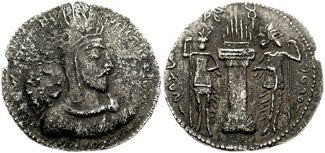
Source: http://www.cngcoins.com/Coin.aspx?CoinID=48403
(downloaded June 2006)
"HEPHTHALITES. Baktria? Circa 350 AD. AR Drachm (3.43 gm). Imitating Sasanian king Shahpur I. Tall narrow bust resembling Shapur I; crown with korymbos and earflap / Fire altar flanked by attendants, sprig and caduceus to either side of flames. This apparently unpublished imitative dirhem of Shahpur I is possibly one of the first issues of the Hephthalite tribes that settled in Baktria in the 350s AD and established treaty relations with Shahpur II. The sprig and caduceus symbols on the reverse are not found on any other issue, but they may be intended to mimic the wreath and taurus symbols on contemporary Sasanian coins."
Clik here to view.

Source: http://www.vcoins.com/ancient/dltcoins/store/viewItem.asp?idProduct=884&large=1
(downloaded June 2006)
"Hephthalites, Khingila. AR Drachm. c. AD 440-490/ Mint" Taxila (?)/ Obverse Brahmi Khi-Gi (for "Khingila"). Tall, Central-Asian bust right, wearing diadem, earrings and necklace; tamgha behind head. Reverse Fire altar with attendants, bust in flames. Weight 3.59gm Diameter 26mm."
Clik here to view.
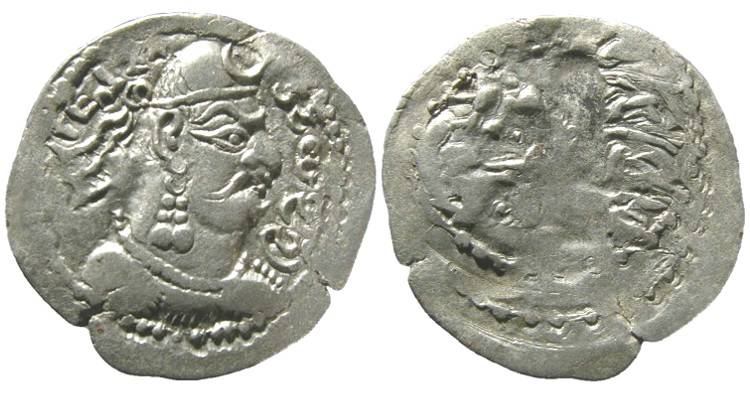
Source: http://www.vcoins.com/ancient/dltcoins/store/viewItem.asp?idProduct=874&large=1
(downloaded June 2006)
"Hephthalites, Raja Lakhana Udayaditya. AR Drachm; c. late 5th - end 6th century. Obverse: Brahmi legend, Raja Lakhana Udayaditya. Tall Central-Asiatic bust right, wearing diadem with crescent and large earrings. Reverse: Traces of fire altar with attendants design. Weight 3.72gm.Diameter 28mm." [Image and description courtesy of *David L. Tranbarger Rare Coins*.]
Clik here to view.
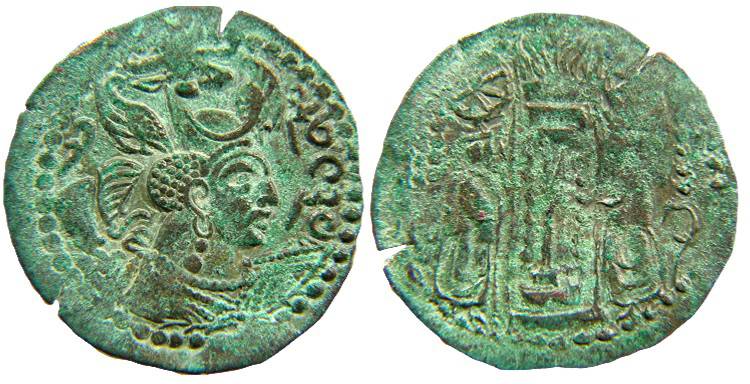
Source: http://www.vcoins.com/ancient/dltcoins/store/viewItem.asp?idProduct=1179&large=1
(downloaded July 2006)
"Nezak Malkas, Unknown Ruler. AE Drachm, c. AD 630-711. Mint: Kapisa, Kabul. Obverse: Pahlavi legend. Bust r., wearing winged buffalo crown. Reverse: Fire altar with highly stylized attendants, wheel above each. Weight 3.35gm. Diameter 27mm. "Nezak Malka" is generally considered to be a title, not the ruler's personal name. The Nezak Malkas were a Turco-Hephthalite dynasty who ruled Kabul, Ghazni and Gandhara as vassals of the Western Turk Yabghu at Qunduz. In recent years, the dating of these coins has been placed firmly in the 7th century rather than the 6th as previously thought (Gobl, Mitchiner, etc), thus placing the Nezak "Huns" in the Turkic period rather than the Hephthalite." [Image and description courtesy of *David L. Tranbarger Rare Coins*.]
http://www.columbia.edu/itc/mealac/pritchett/00routesdata/0400_0499/hunacoins/hunacoins.html
HEPHTHALITE coins
The Hephthalites were nomads who showed up in Iran-Afghanistan-Pakistan-Kashmir starting in the 4th century AD. They came, as all Eurasian nomads did, from the northeast. Their ethnic makeup is unknown at this time. Their cultural aspects are for the most part obscure. It is a matter of debate whether they were related to the Huns who invaded the Roman empire, though they call themselves "Hono" on some of their coins.
Most of their relics are the coins they struck from eastern Iran to India. They captured the Sasanian shah Peroz and held him for ransom. The millions of Sasanian silver coins with which that ransom was paid marked the start of their venture into coinage. They countermarked them and copied them, and went on from there. Hephthalite coinage continued for a few hundred years before the Hephthalites dissolved into the local populations.
Hephthalite coins are all imitative. Most imitate Sasanian types, a few imitate Kushans, and there are some imitations of Greek and Scythian coins that may also be Hephthalite, notwithstanding the half millennium gap between the originals and the the imitations.
It is possible that some of the coins typically classified as Hephthalite these days are not ethnically Hephthalite at all. There are enough gaps in the history of the region to hide large kingdoms and longlived dynasties.
A lot of newly seen Hephthalite types are coming out these days (1990s-2000s). Nice ones in gold and silver can be quite expensive.
Image may be NSFW.
Clik here to view.
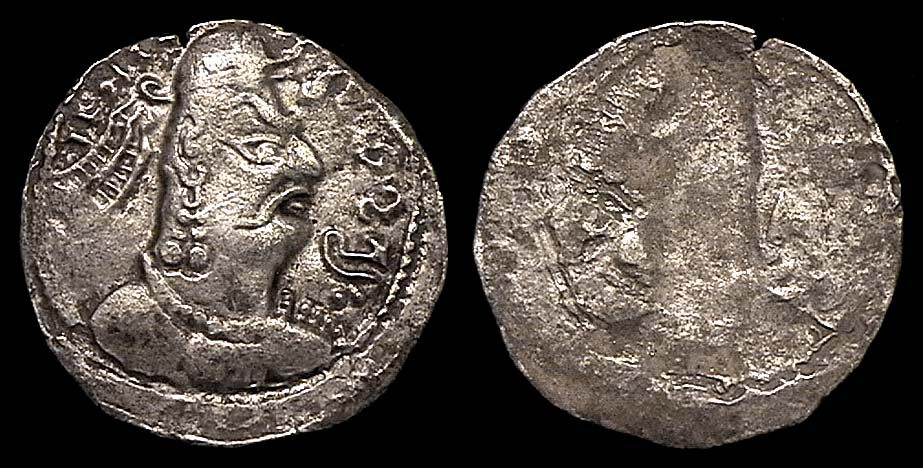 HEPHTHALITE, Khingila, c. 430-490 AD, 27mm silver drachm, G-79, tall bust R, RAJA LAKHANA (UDAYA) DITYA / traces of fire altar,
HEPHTHALITE, Khingila, c. 430-490 AD, 27mm silver drachm, G-79, tall bust R, RAJA LAKHANA (UDAYA) DITYA / traces of fire altar, | Obverse | Bust of king right, wearing crescent-crested crown, Brahmi legend around, at left: rajalakhana, at right: udayaditya |
| Reverse | Fire altar, with armed attendants standing left and right, obliterated as usual for these coins |
| Date | c. 5th century CE |
| Weight | 3.55 gm. |
| Diameter | 28-30 mm. |
| Die axis | ? |
| Reference | Göbl Hunnen 79 |
| Comments | Probably issued in Taxila. Note the elongated head typical of these Huns who practiced head binding. Normally the legend for this coin is written as Raja Lakhana Udayaditya, but I have instead written it as Rajalakhana Udayaditya, on the theory that it might be intended to be a conjoined version of Raja Alakhana Udayaditya, i.e., Udayaditya, the Alchon king. A choice specimen, with a bold portrait! The style of Udayaditya's coins reveals that he was a successor of Khingila. |
Image may be NSFW.
Clik here to view.
 HEPHTHALITE, Khingila, c. 430-490 AD, 23mm silver drachm, MA-1424v, like Göbl Em. 81, tall moustached bust R, tamgha behind, flowers in vase before / traces of fire altar, Afghanistan issue, compact flan,
HEPHTHALITE, Khingila, c. 430-490 AD, 23mm silver drachm, MA-1424v, like Göbl Em. 81, tall moustached bust R, tamgha behind, flowers in vase before / traces of fire altar, Afghanistan issue, compact flan, | Obverse | Bust of king right, lunar crescents on shoulder, tamgha at left, medallion or sun wheel at right, Brahmi legend above: Devashahi ... Khingila |
| Reverse | Fire altar, with armed attendants standing left and right, obliterated as usual for these coins |
| Date | c. 5th century CE |
| Weight | 3.60 gm. |
| Diameter | 26.5 mm. |
| Die axis | 3 o'clcock |
| Reference | Göbl Hunnen 81 |
Image may be NSFW.
Clik here to view.
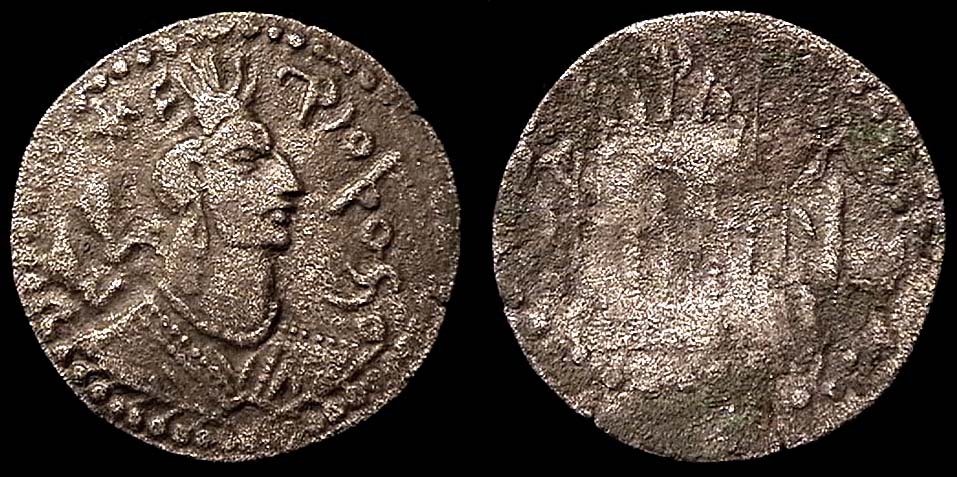 HM1491a) HEPHTHALITE, c. 475-576 AD, billon drachm, MA-1491, Napki Malka type bust, SRIO SHAHO in cursive Greek / fire altar, western Afghanistan.
HM1491a) HEPHTHALITE, c. 475-576 AD, billon drachm, MA-1491, Napki Malka type bust, SRIO SHAHO in cursive Greek / fire altar, western Afghanistan. Image may be NSFW.
Clik here to view.
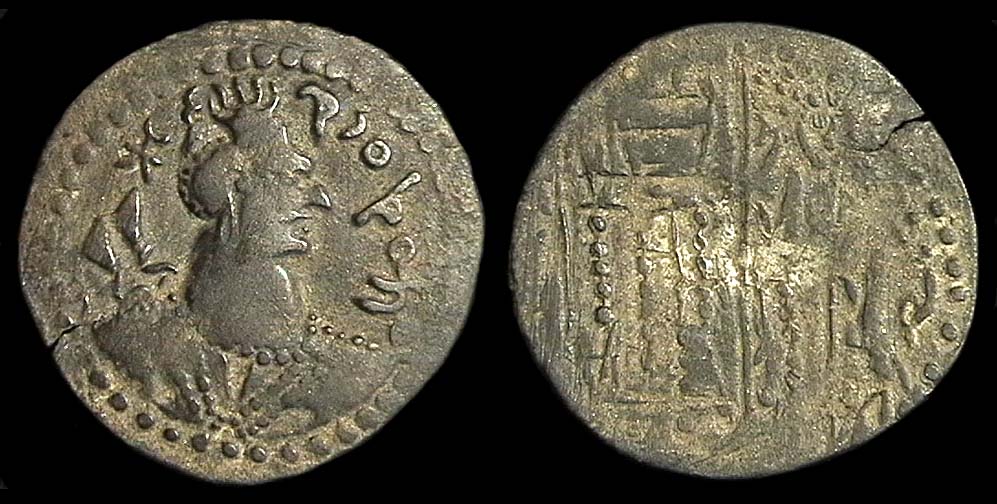 HM1491b) HEPHTHALITE, c. 475-576 AD, billon drachm, MA-1491, Napki Malka type bust, SRIO SHAHO in cursive Greek / fire altar, western Afghanistan, small split on edge
HM1491b) HEPHTHALITE, c. 475-576 AD, billon drachm, MA-1491, Napki Malka type bust, SRIO SHAHO in cursive Greek / fire altar, western Afghanistan, small split on edgeImage may be NSFW.
Clik here to view.
 276-81. HEPHTHALITE, c. 475-576 AD, billon drachm, MA-1493, Napki Malka type bust, SRIO SHAHO in cursive Greek / fire altar, nice style, decent rev., porous obv, crude planchet,
276-81. HEPHTHALITE, c. 475-576 AD, billon drachm, MA-1493, Napki Malka type bust, SRIO SHAHO in cursive Greek / fire altar, nice style, decent rev., porous obv, crude planchet,Image may be NSFW.
Clik here to view.
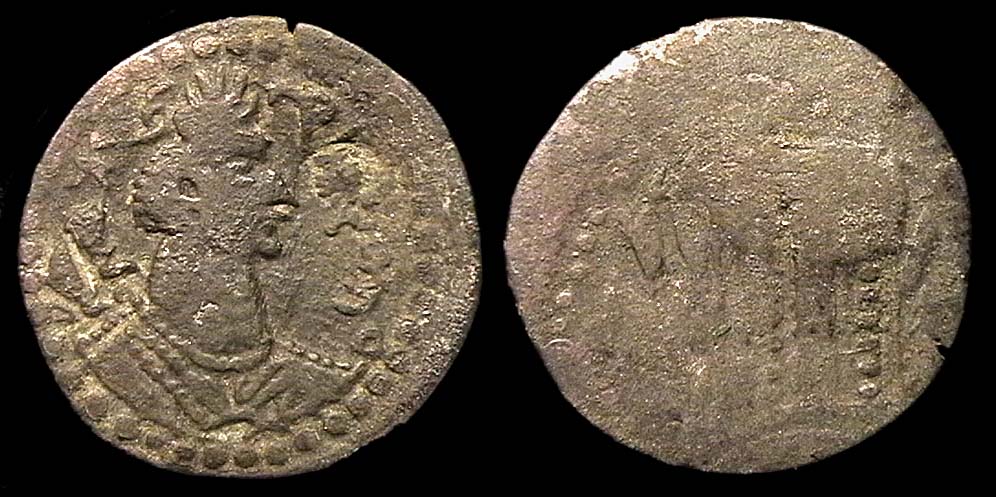 HEPHTHALITE, c. 475-576 AD, billon drachm, MA-1494, Napki Malka type bust, SRIO SHAHO in cursive Greek with "beetle" countermark / fire altar, western Afghanistan, slightly dirty
HEPHTHALITE, c. 475-576 AD, billon drachm, MA-1494, Napki Malka type bust, SRIO SHAHO in cursive Greek with "beetle" countermark / fire altar, western Afghanistan, slightly dirty Image may be NSFW.
Clik here to view.
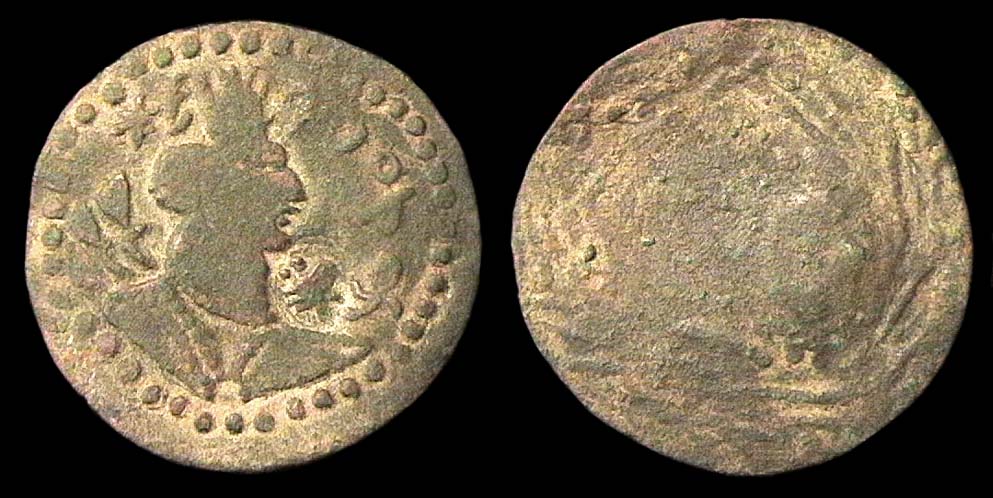 HEPHTHALITE, c. 475-576 AD, billon drachm, MA-1494, Napki Malka type bust, SRIO SHAHO in cursive Greek with "beetle" countermark / wreath(?) rev. I showed this coin to several people, all of whom guessed it was a multiple strike of some sort. I do not find that idea convincing. The "wreath" is poorly struck, apparently nothing is inside. Patinated
HEPHTHALITE, c. 475-576 AD, billon drachm, MA-1494, Napki Malka type bust, SRIO SHAHO in cursive Greek with "beetle" countermark / wreath(?) rev. I showed this coin to several people, all of whom guessed it was a multiple strike of some sort. I do not find that idea convincing. The "wreath" is poorly struck, apparently nothing is inside. PatinatedImage may be NSFW.
Clik here to view.
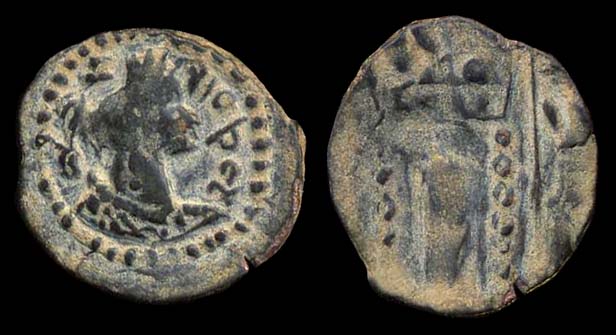 HEPHTHALITE, c. 475-576 AD, billon 1/4 drachm, MA-1495, Napki Malka type bust, SRI SHAHO in cursive Greek / fire altar,
HEPHTHALITE, c. 475-576 AD, billon 1/4 drachm, MA-1495, Napki Malka type bust, SRI SHAHO in cursive Greek / fire altar,Image may be NSFW.
Clik here to view.
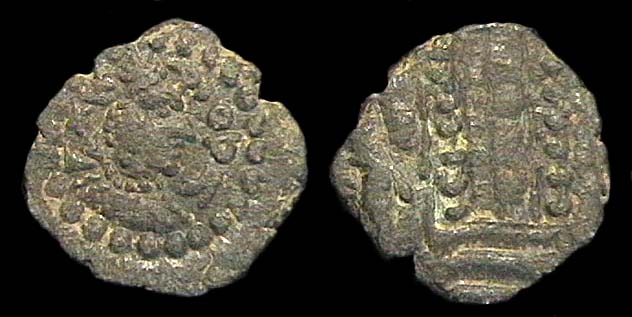 HEPHTHALITE, c. 475-576 AD, billon 1/4 drachm, MA-1495, Napki Malka type bust, SRI SHAHO in cursive Greek / fire altar, slightly porous
HEPHTHALITE, c. 475-576 AD, billon 1/4 drachm, MA-1495, Napki Malka type bust, SRI SHAHO in cursive Greek / fire altar, slightly porousImage may be NSFW.
Clik here to view.
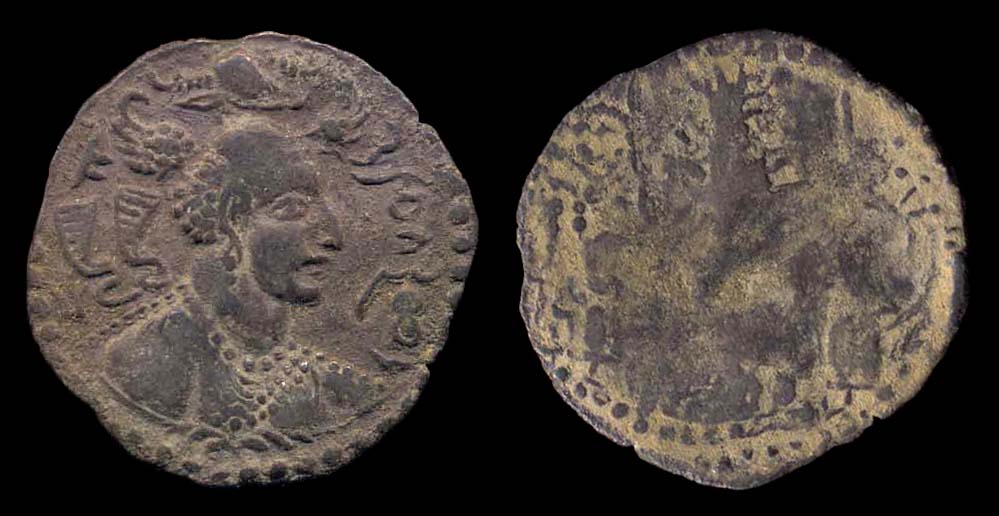 HEPHTHALITE, c. 475-576 AD, silver drachm, MA-1500, Napki Malka type bust, SRI SHAHO in cursive Greek / fire altar
HEPHTHALITE, c. 475-576 AD, silver drachm, MA-1500, Napki Malka type bust, SRI SHAHO in cursive Greek / fire altar Image may be NSFW.
Clik here to view.
 HEPHTHALITE, c. 475-576 AD, silver drachm, MA-1500, bust R with bull head crown, Napki Malka in Pahlavi, angular S behind / fire altar, Kabul/Zabul region
HEPHTHALITE, c. 475-576 AD, silver drachm, MA-1500, bust R with bull head crown, Napki Malka in Pahlavi, angular S behind / fire altar, Kabul/Zabul regionImage may be NSFW.
Clik here to view.
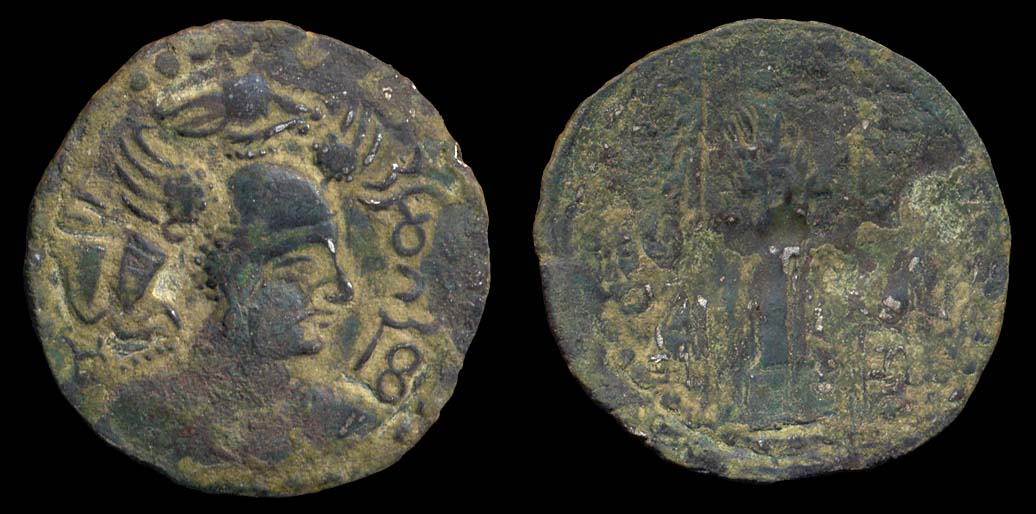 HEPHTHALITE, c. 475-576 AD, billon drachm, MA-1500, bust R with bull head crown, Napki Malka in Pahlavi / fire altar, Kabul/Zabul region.
HEPHTHALITE, c. 475-576 AD, billon drachm, MA-1500, bust R with bull head crown, Napki Malka in Pahlavi / fire altar, Kabul/Zabul region. Image may be NSFW.
Clik here to view.
 HEPHTHALITE, c. 475-576 AD, silver drachm, MA-1500, bust R with bull head crown, Napki Malka in Pahlavi, angular S behind / fire altar, Kabul/Zabul region,
HEPHTHALITE, c. 475-576 AD, silver drachm, MA-1500, bust R with bull head crown, Napki Malka in Pahlavi, angular S behind / fire altar, Kabul/Zabul region,Image may be NSFW.
Clik here to view.
 HEPHTHALITE, c. 475-576 AD, silver drachm, MA-1500, bust R with bull head crown, Napki Malka in Pahlavi / fire altar, Kabul/Zabul region, excellent
HEPHTHALITE, c. 475-576 AD, silver drachm, MA-1500, bust R with bull head crown, Napki Malka in Pahlavi / fire altar, Kabul/Zabul region, excellentImage may be NSFW.
Clik here to view.
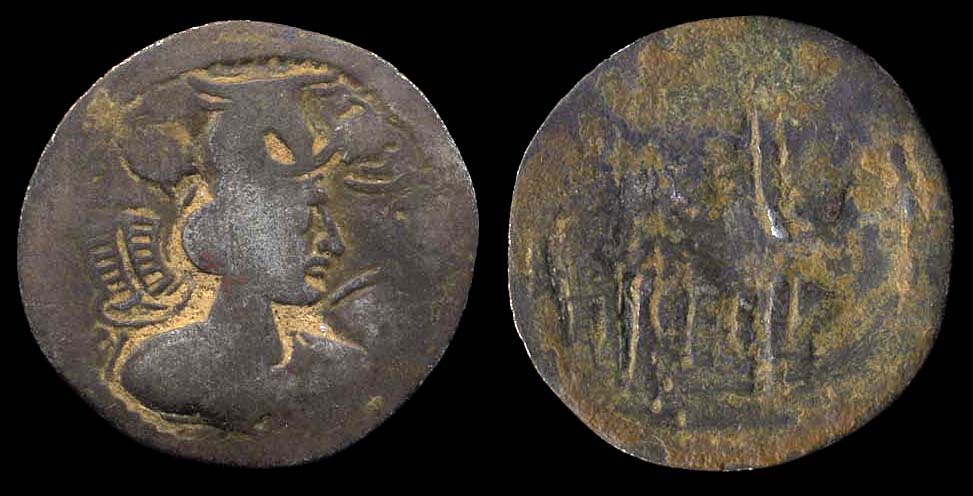 HEPHTHALITE, c. 475-576 AD, silver drachm, MA-1501, bust R with bull head crown, Napki Malka in Pahlavi / fire altar, Kabul/Zabul region
HEPHTHALITE, c. 475-576 AD, silver drachm, MA-1501, bust R with bull head crown, Napki Malka in Pahlavi / fire altar, Kabul/Zabul regionImage may be NSFW.
Clik here to view.
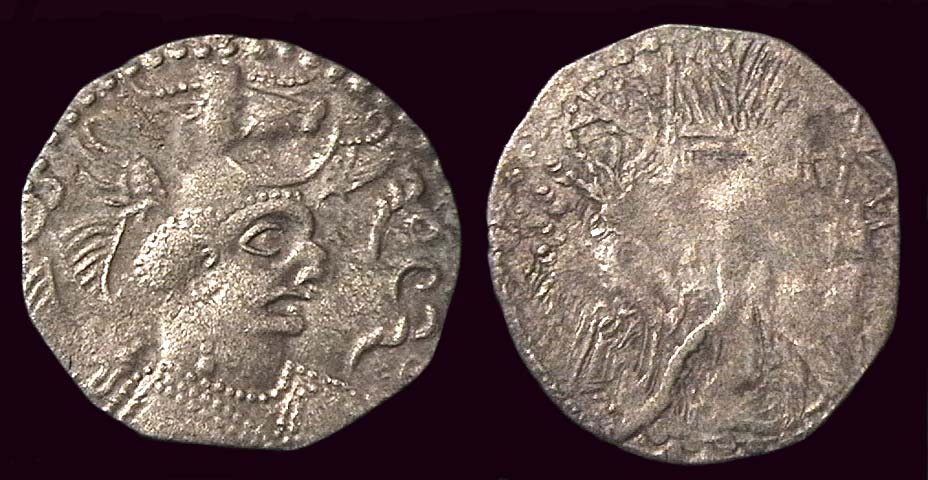 HM1502a) HEPHTHALITE, c. 475-576 AD, billon drachm, MA-1502+, bust R with bull head crown, Napki Malka in Pahlavi / fire altar, Kabul/Zabul, excellent
HM1502a) HEPHTHALITE, c. 475-576 AD, billon drachm, MA-1502+, bust R with bull head crown, Napki Malka in Pahlavi / fire altar, Kabul/Zabul, excellentImage may be NSFW.
Clik here to view.
 HM1502b) HEPHTHALITE, c. 475-576 AD, billon drachm, MA-1502+, bust R with bull head crown, Napki (or Nezak) Malka in Pahlavi, S behind / fire altar with sun wheels above attendants, Kabul/Zabul
HM1502b) HEPHTHALITE, c. 475-576 AD, billon drachm, MA-1502+, bust R with bull head crown, Napki (or Nezak) Malka in Pahlavi, S behind / fire altar with sun wheels above attendants, Kabul/ZabulImage may be NSFW.
Clik here to view.
 HM1502c) HEPHTHALITE, c. 475-576 AD, billon drachm, MA-1502+, bust R with bull head crown, Napki Malka in Pahlavi / fire altar, Kabul/Zabul, superb
HM1502c) HEPHTHALITE, c. 475-576 AD, billon drachm, MA-1502+, bust R with bull head crown, Napki Malka in Pahlavi / fire altar, Kabul/Zabul, superbImage may be NSFW.
Clik here to view.
 HM1502d) HEPHTHALITE, c. 475-576 AD, billon drachm, MA-1502+, bust R with bull head crown, Napki Malka in Pahlavi / fire altar, Kabul/Zabul, outstanding
HM1502d) HEPHTHALITE, c. 475-576 AD, billon drachm, MA-1502+, bust R with bull head crown, Napki Malka in Pahlavi / fire altar, Kabul/Zabul, outstandingImage may be NSFW.
Clik here to view.
 HEPHTHALITE, c. 475-576 AD, billon drachm, MA-1502, bust R with bull head crown, Napki Malka in Pahlavi / fire altar, Kabul/Zabul region
HEPHTHALITE, c. 475-576 AD, billon drachm, MA-1502, bust R with bull head crown, Napki Malka in Pahlavi / fire altar, Kabul/Zabul regionImage may be NSFW.
Clik here to view.
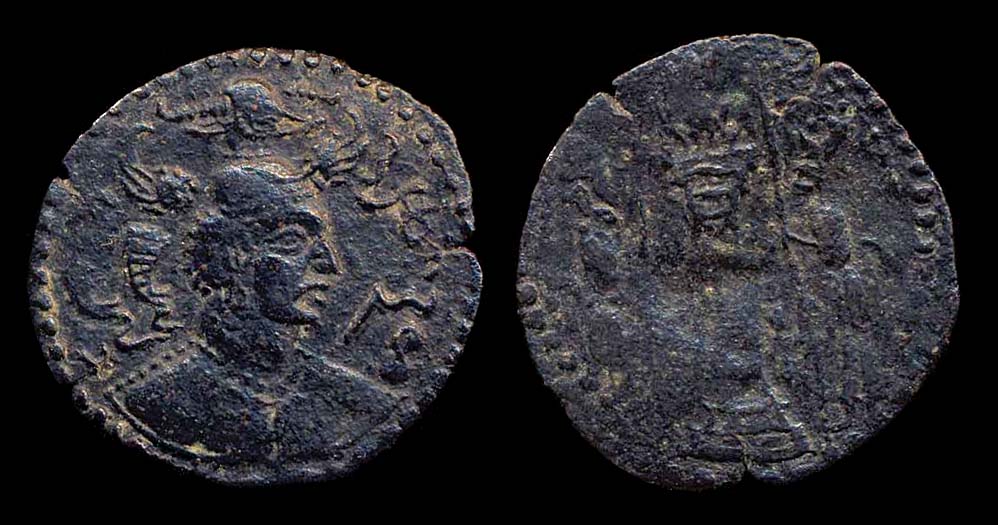 HEPHTHALITE, c. 475-576 AD, billon drachm, MA-1502, similar, angular S behind head / fire altar, Kabul/Zabul
HEPHTHALITE, c. 475-576 AD, billon drachm, MA-1502, similar, angular S behind head / fire altar, Kabul/ZabulImage may be NSFW.
Clik here to view.
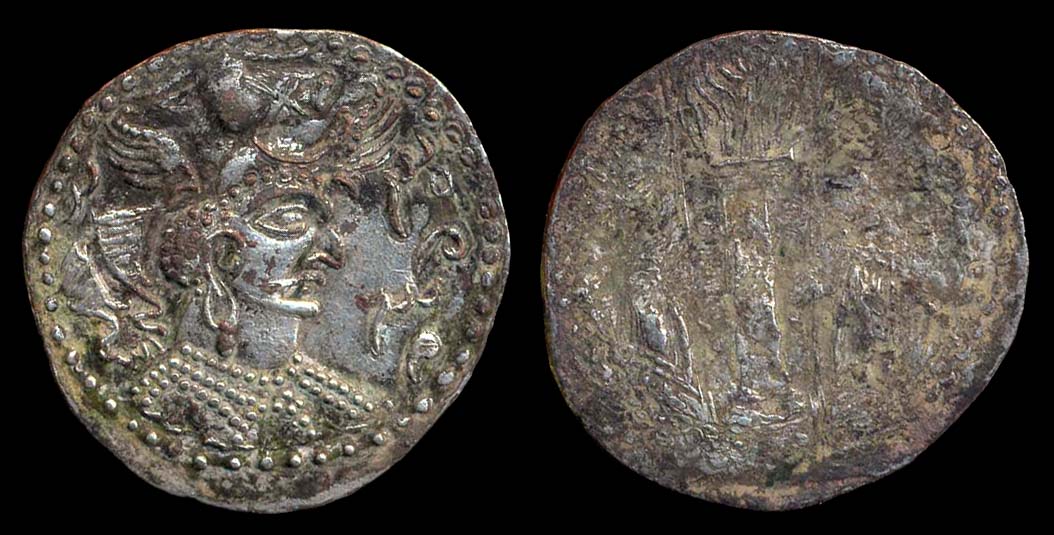 HEPHTHALITE, c. 475-576 AD, billon drachm, silver plated, MA-1507+, bust R with bull head crown, cursive S behind, Napki Malka in Pahlavi / fire altar, Kabul/Zabul region
HEPHTHALITE, c. 475-576 AD, billon drachm, silver plated, MA-1507+, bust R with bull head crown, cursive S behind, Napki Malka in Pahlavi / fire altar, Kabul/Zabul region Image may be NSFW.
Clik here to view.
 HEPHTHALITE, c. 475-576 AD, billon drachm, silver plated, MA-1507+, bust R with bull head crown, cursive S behind, Napki Malka in Pahlavi / fire altar, Kabul/Zabul region, both sides clear
HEPHTHALITE, c. 475-576 AD, billon drachm, silver plated, MA-1507+, bust R with bull head crown, cursive S behind, Napki Malka in Pahlavi / fire altar, Kabul/Zabul region, both sides clearImage may be NSFW.
Clik here to view.
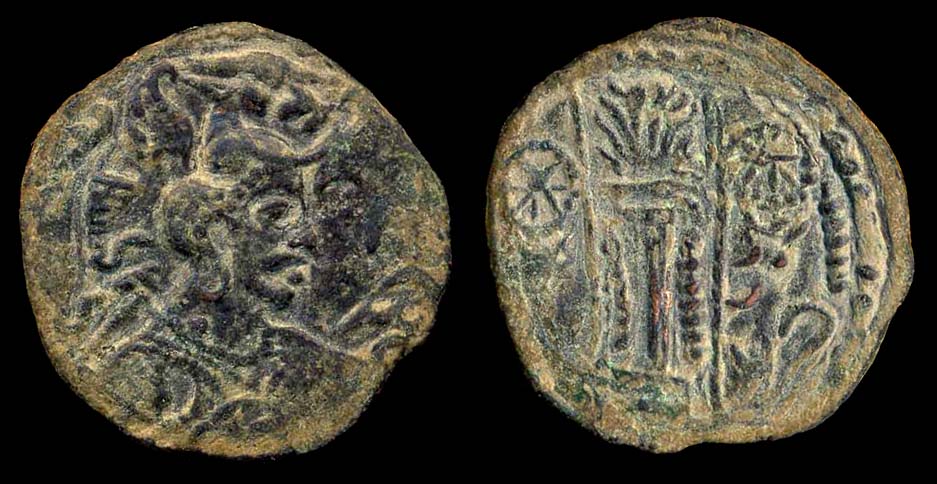 HEPHTHALITE, c. 475-576 AD, billon drachm, MA-1508+, similar, cursive S behind / fire altar with sun wheels above attendants, Kabul/Zabul
HEPHTHALITE, c. 475-576 AD, billon drachm, MA-1508+, similar, cursive S behind / fire altar with sun wheels above attendants, Kabul/ZabulImage may be NSFW.
Clik here to view.
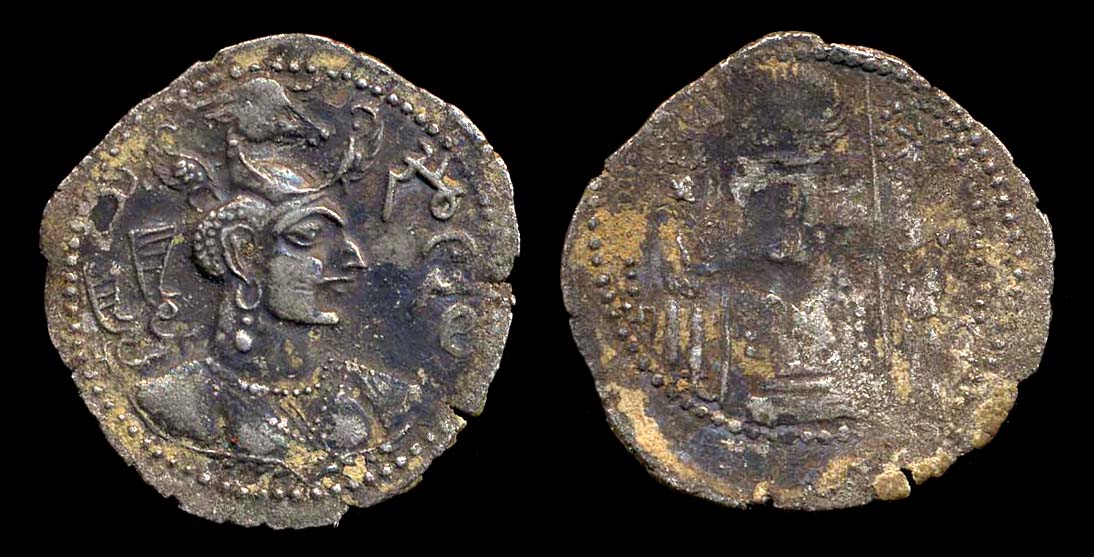 HEPHTHALITE, c. 475-576 AD, billon drachm, MA-1508+, similar, cursive S behind / fire altar with sun wheels above attendants, Kabul/Zabul
HEPHTHALITE, c. 475-576 AD, billon drachm, MA-1508+, similar, cursive S behind / fire altar with sun wheels above attendants, Kabul/ZabulImage may be NSFW.
Clik here to view.
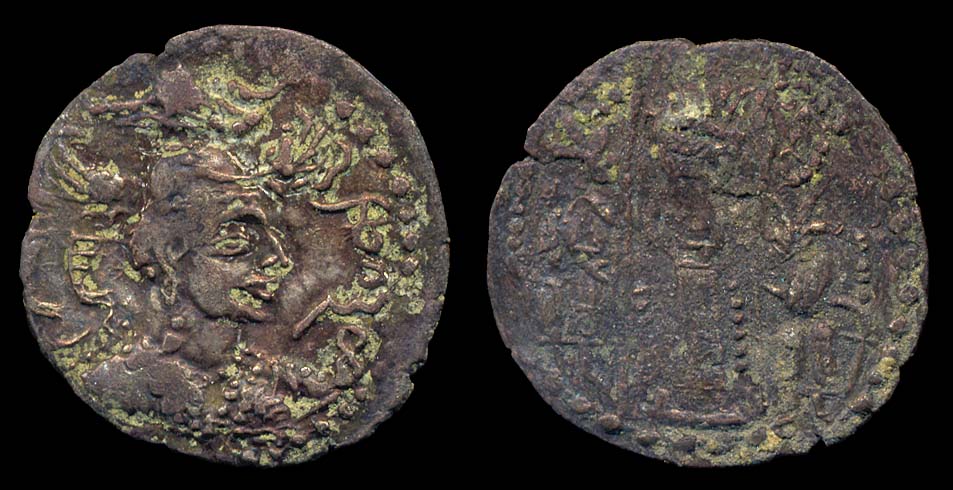 HEPHTHALITE, c. 475-576 AD, billon drachm, MA-1509, bust R with bull head crown, Napki Malka in Pahlavi, S behind / fire altar with sun wheels above attendants, bits of crust
HEPHTHALITE, c. 475-576 AD, billon drachm, MA-1509, bust R with bull head crown, Napki Malka in Pahlavi, S behind / fire altar with sun wheels above attendants, bits of crustImage may be NSFW.
Clik here to view.
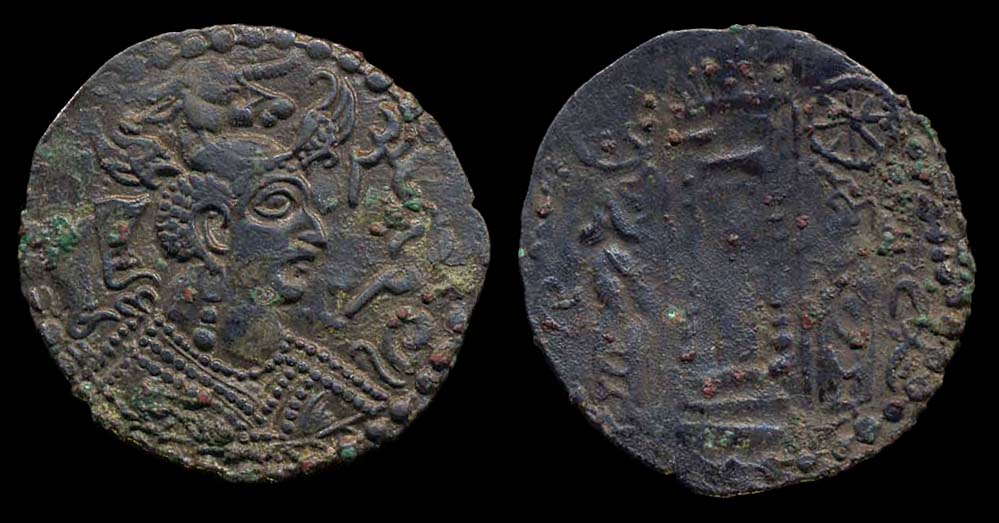 HEPHTHALITE, c. 475-576 AD, billon drachm, MA-1510, bust R with bull head crown, Napki Malka in Pahlavi, S behind / fire altar with sun wheels above attendants
HEPHTHALITE, c. 475-576 AD, billon drachm, MA-1510, bust R with bull head crown, Napki Malka in Pahlavi, S behind / fire altar with sun wheels above attendantsImage may be NSFW.
Clik here to view.
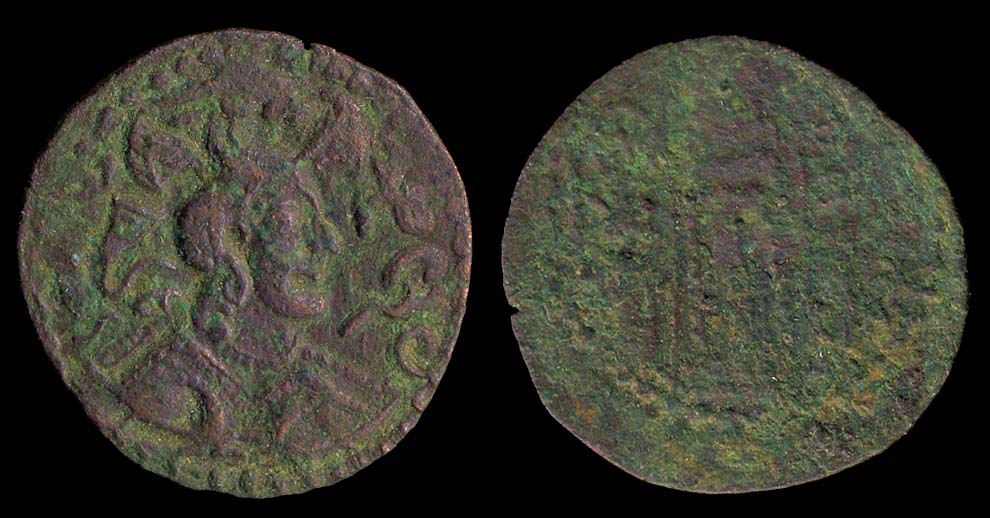 HEPHTHALITE, c. 475-576 AD, billon drachm, MA-1510, bust R with bull head crown, Napki (or Nezak) Malka in Pahlavi, S behind / fire altar with sun wheels above attendants, Kabul/Zabul,
HEPHTHALITE, c. 475-576 AD, billon drachm, MA-1510, bust R with bull head crown, Napki (or Nezak) Malka in Pahlavi, S behind / fire altar with sun wheels above attendants, Kabul/Zabul, Image may be NSFW.
Clik here to view.
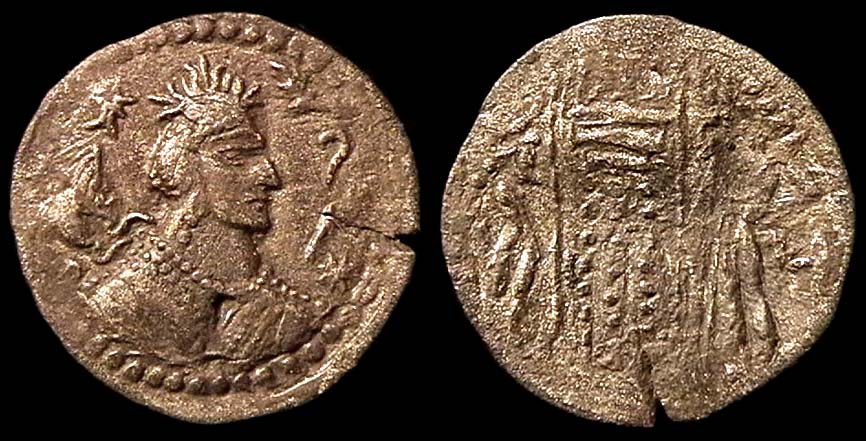 HEPHTHALITE, c. 475-576 AD, billon drachm, MA-1520+, bust R, NAPKI MALKA in Pahlavi, Gandhara, split edge.
HEPHTHALITE, c. 475-576 AD, billon drachm, MA-1520+, bust R, NAPKI MALKA in Pahlavi, Gandhara, split edge. Image may be NSFW.
Clik here to view.
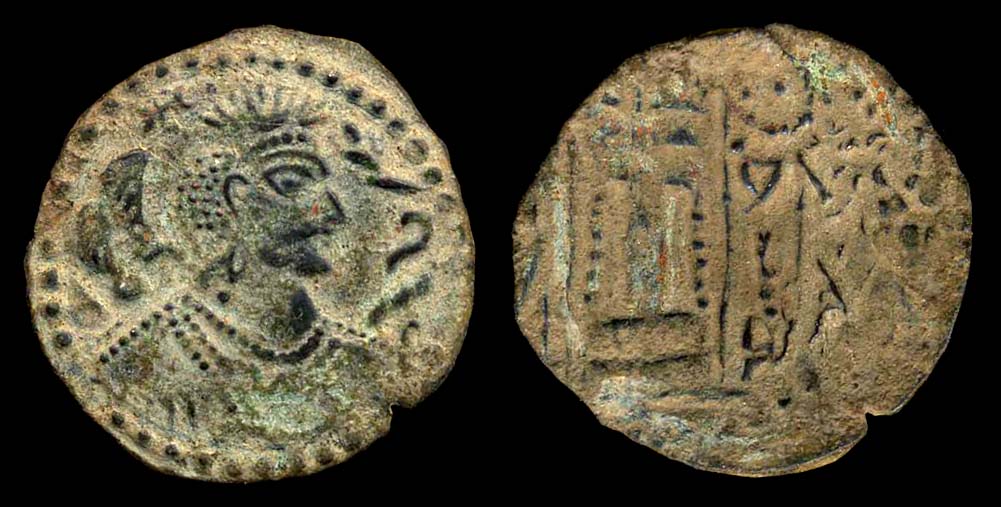 HEPHTHALITE, c. 475-576 AD, billon drachm, MA-1520+, bust R with tendril hat, NAPKI MALKA in Pahlavi, Gandhara
HEPHTHALITE, c. 475-576 AD, billon drachm, MA-1520+, bust R with tendril hat, NAPKI MALKA in Pahlavi, GandharaImage may be NSFW.
Clik here to view.
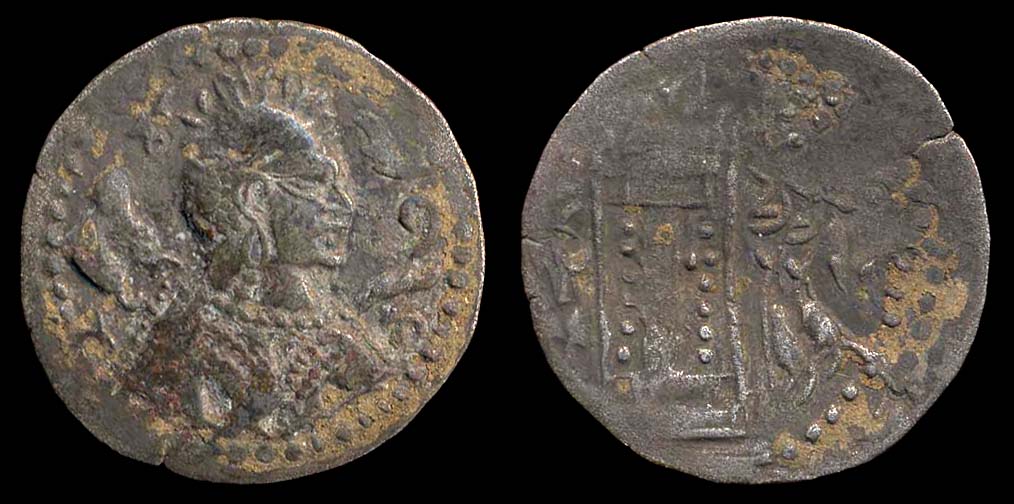 HEPHTHALITE, c. 475-576 AD, billon drachm, MA-1520+, bust R, NAPKI MALKA in Pahlavi, Gandhara
HEPHTHALITE, c. 475-576 AD, billon drachm, MA-1520+, bust R, NAPKI MALKA in Pahlavi, GandharaImage may be NSFW.
Clik here to view.
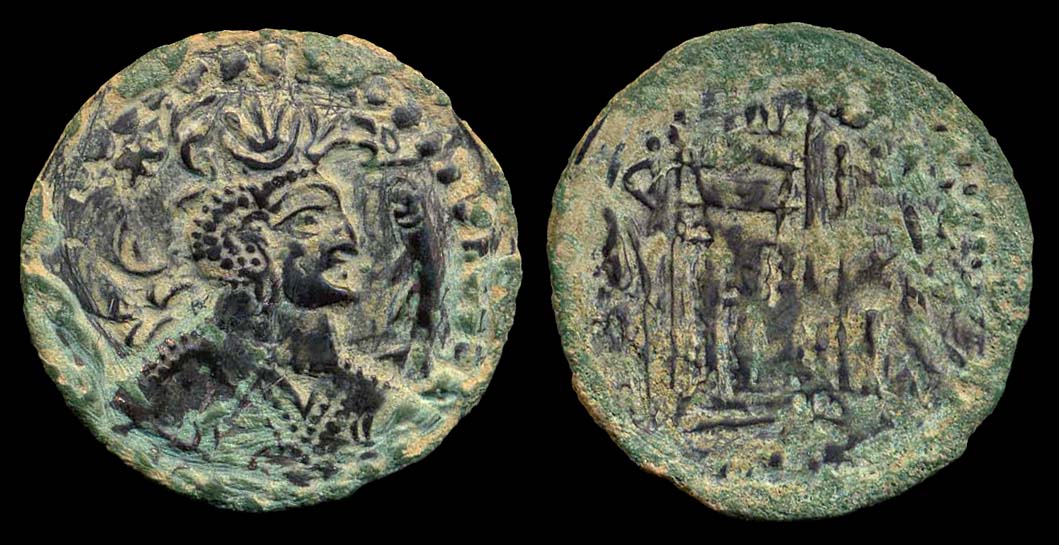 HEPHTHALITE, c. 475-576 AD, billon drachm, MA-1523v, bust R with trident over moon crown, abbreviated NAPKI MALKA in Pahlavi, baton before, Gandhara
HEPHTHALITE, c. 475-576 AD, billon drachm, MA-1523v, bust R with trident over moon crown, abbreviated NAPKI MALKA in Pahlavi, baton before, GandharaImage may be NSFW.
Clik here to view.
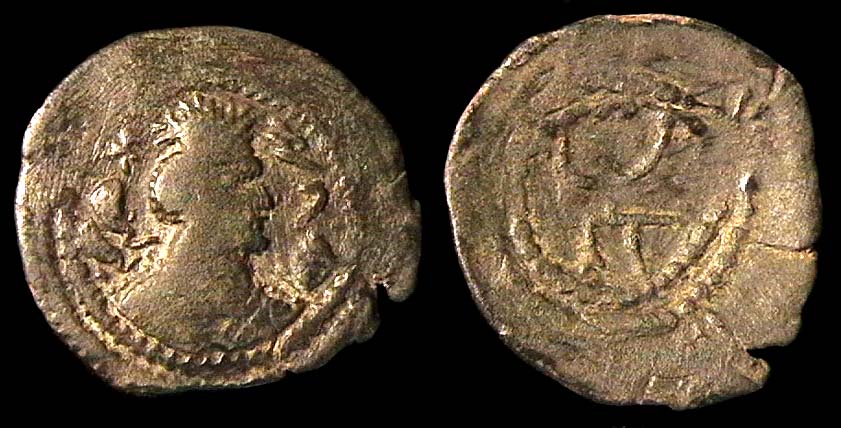 HEPHTHALITE, GANDHARA, c. 475-576, copper drachm, MA-1527, bust R / large tamgha
HEPHTHALITE, GANDHARA, c. 475-576, copper drachm, MA-1527, bust R / large tamgha Image may be NSFW.
Clik here to view.
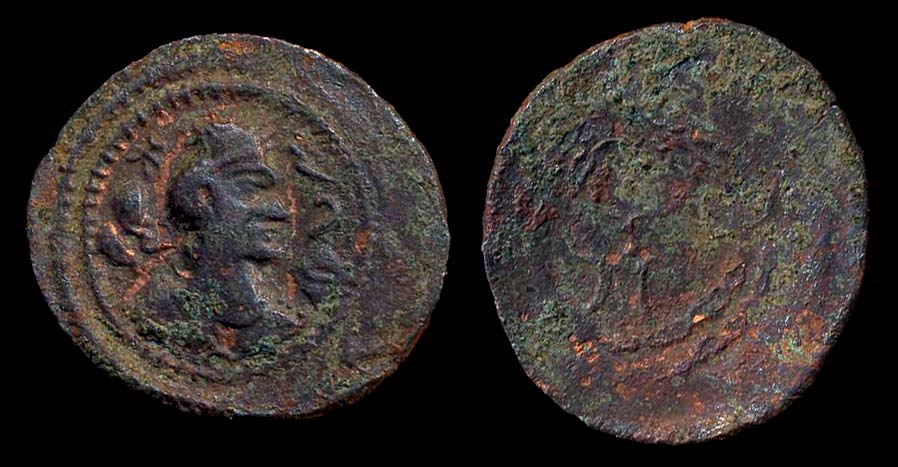 HEPHTHALITE, GANDHARA, c. 475-576, copper drachm, MA-1527, bust R / small tamgha
HEPHTHALITE, GANDHARA, c. 475-576, copper drachm, MA-1527, bust R / small tamghaImage may be NSFW.
Clik here to view.
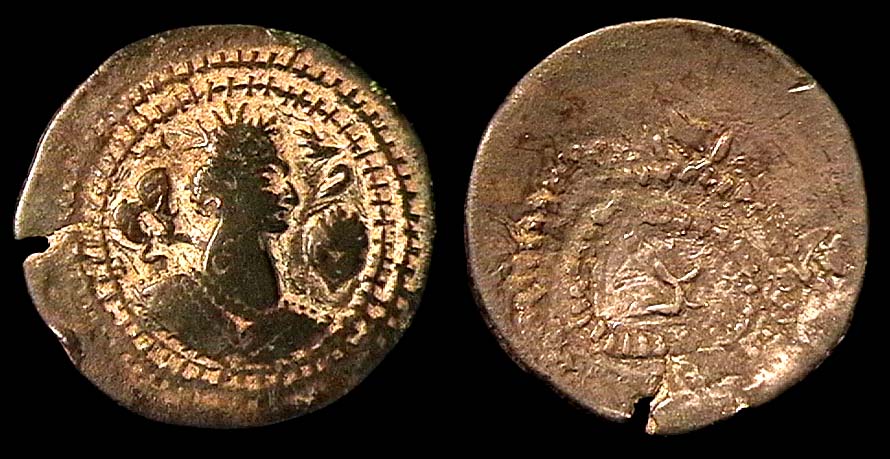 HEPHTHALITE, GANDHARA, c. 475-576, copper drachm, MA-1527v, bust R / small tamgha
HEPHTHALITE, GANDHARA, c. 475-576, copper drachm, MA-1527v, bust R / small tamghaHEPHTHALITE, GANDHARA, c. 475-576, copper hemidrachm, Sasanian types with Sri Shaho legend in Pahlavi, MA-1529,
Image may be NSFW.
Clik here to view.
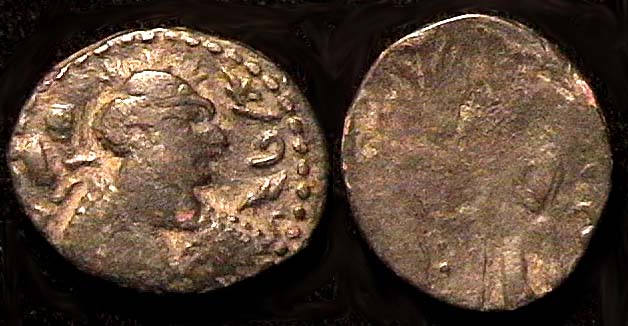 a) nice
a) niceImage may be NSFW.
Clik here to view.
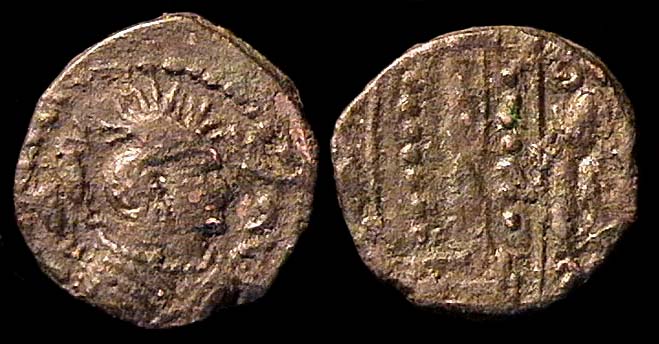 b) a bit crusty
b) a bit crustyImage may be NSFW.
Clik here to view.
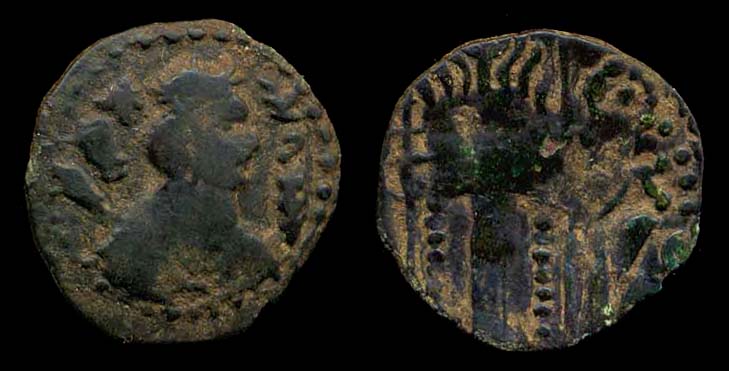 HEPHTHALITE, GANDHARA, c. 475-576, copper hemidrachm, MA-1529, Sasanian types with Sri Shaho legend in Pahlavi
HEPHTHALITE, GANDHARA, c. 475-576, copper hemidrachm, MA-1529, Sasanian types with Sri Shaho legend in Pahlavi Image may be NSFW.
Clik here to view.
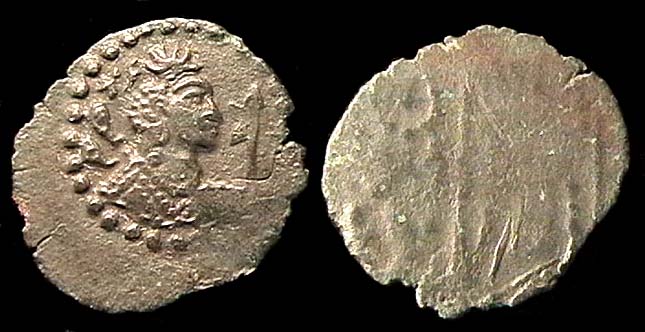 HEPHTHALITE, GANDHARA, c. 475-576, 14mm copper (1/8 drachm?), like MA-1529
HEPHTHALITE, GANDHARA, c. 475-576, 14mm copper (1/8 drachm?), like MA-1529Image may be NSFW.
Clik here to view.
 HEPHTHALITE, GANDHARA, c. 475-576, copper hemidrachm, MA-1533, NAPKI MALKA in Pahlavi / fire altar
HEPHTHALITE, GANDHARA, c. 475-576, copper hemidrachm, MA-1533, NAPKI MALKA in Pahlavi / fire altarImage may be NSFW.
Clik here to view.
 274-42. HEPHTHALITE, GANDHARA, c. 475-576, 18mm copper 1/4 drachm, MA-1541, bust R, standard before / fire altar,
274-42. HEPHTHALITE, GANDHARA, c. 475-576, 18mm copper 1/4 drachm, MA-1541, bust R, standard before / fire altar,Image may be NSFW.
Clik here to view.
 HEPHTHALITE, GANDHARA, c. 475-576, 13mm copper, 0.7g, MA-1541v1, unusual style
HEPHTHALITE, GANDHARA, c. 475-576, 13mm copper, 0.7g, MA-1541v1, unusual styleImage may be NSFW.
Clik here to view.
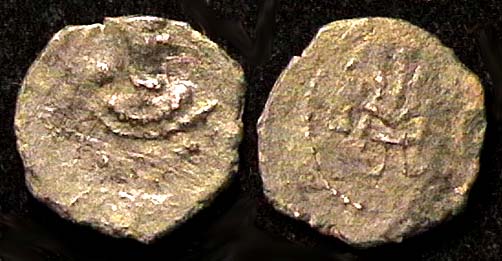 HEPHTHALITE, GANDHARA, c. 475-576 (?), 12mm copper , 0.1g, Napki type bust R / tamgha like Chach in Uzbekistan!, obv. like MA-1534, rev. see Ziemal
HEPHTHALITE, GANDHARA, c. 475-576 (?), 12mm copper , 0.1g, Napki type bust R / tamgha like Chach in Uzbekistan!, obv. like MA-1534, rev. see ZiemalImage may be NSFW.
Clik here to view.
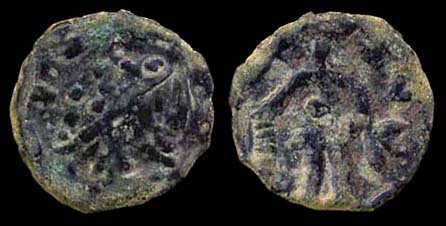 HEPHTHALITE, GANDHARA, c. 475-576 (?), 11mm copper, 0.6g, Smast type, Zem-x2, imitation of Kujula Herakles type tetradrachm
HEPHTHALITE, GANDHARA, c. 475-576 (?), 11mm copper, 0.6g, Smast type, Zem-x2, imitation of Kujula Herakles type tetradrachmImage may be NSFW.
Clik here to view.
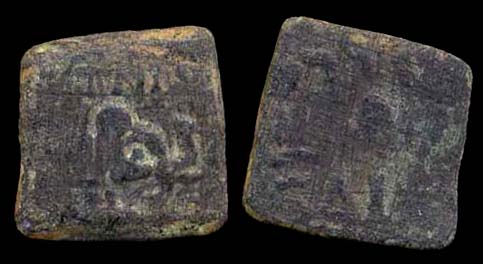 HEPHTHALITE, GANDHARA, c. 475-576 (?), 11mm square copper, 1.4g, imitation of Menander elephant head / club chalkous
HEPHTHALITE, GANDHARA, c. 475-576 (?), 11mm square copper, 1.4g, imitation of Menander elephant head / club chalkousImage may be NSFW.
Clik here to view.
 HEPHTHALITE, GANDHARA, c. 475-576 (?), Kashmir Smast series, 15mm copper, 1.2g, Zem-x4, beardless bust 1/4 R, scepter held in raised L hand / fancifully evolved fire altar with attendants, a bit porous obv.
HEPHTHALITE, GANDHARA, c. 475-576 (?), Kashmir Smast series, 15mm copper, 1.2g, Zem-x4, beardless bust 1/4 R, scepter held in raised L hand / fancifully evolved fire altar with attendants, a bit porous obv. Image may be NSFW.
Clik here to view.
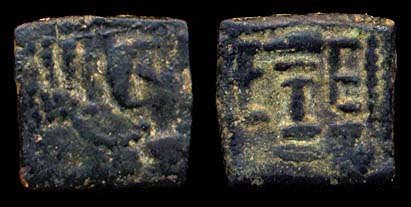 HEPHTHALITE, GANDHARA, c. 475-576 (?), Kashmir Smast series, 9mm square copper, Zem-x5, Sasanian bust R / schematic fire altar.
HEPHTHALITE, GANDHARA, c. 475-576 (?), Kashmir Smast series, 9mm square copper, Zem-x5, Sasanian bust R / schematic fire altar.Image may be NSFW.
Clik here to view.
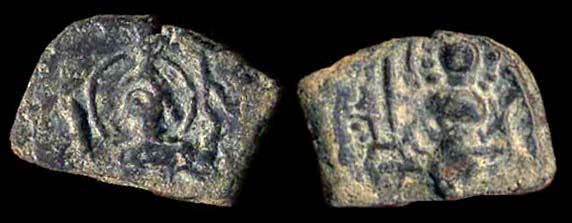 HEPHTHALITE, GANDHARA, c. 475-576 (?), Kashmir Smast series, 10-13mm, standing king / Ardoksho seated
HEPHTHALITE, GANDHARA, c. 475-576 (?), Kashmir Smast series, 10-13mm, standing king / Ardoksho seatedImage may be NSFW.
Clik here to view.
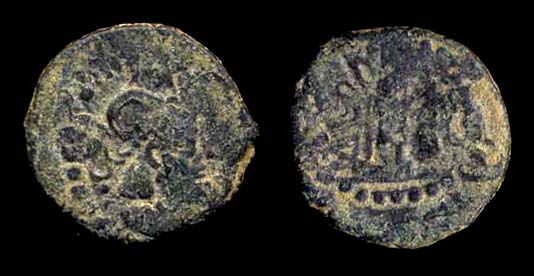 HEPHTHALITE, GANDHARA, c. 475-576 (?), Kashmir Smast series, 9mm square copper, Zem-x5, Sasanian bust R / schematic fire altar, crude
HEPHTHALITE, GANDHARA, c. 475-576 (?), Kashmir Smast series, 9mm square copper, Zem-x5, Sasanian bust R / schematic fire altar, crudeImage may be NSFW.
Clik here to view.
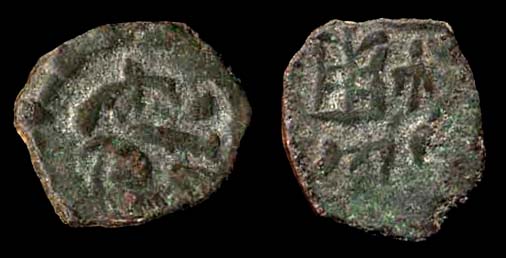 HEPHTHALITE, GANDHARA, c. 475-576 (?), 12-13mm copper, standing figure / tripod, types adapted from Apollodotos I bronze
HEPHTHALITE, GANDHARA, c. 475-576 (?), 12-13mm copper, standing figure / tripod, types adapted from Apollodotos I bronzeImage may be NSFW.
Clik here to view.
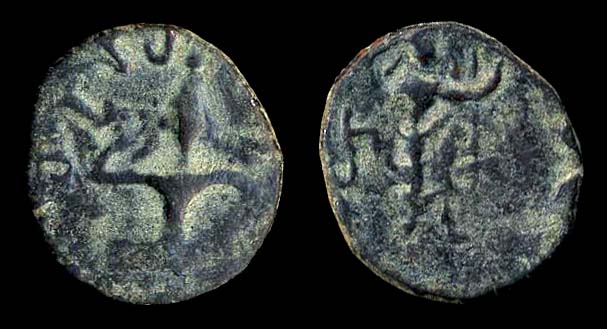 HEPHTHALITE, GANDHARA, c. 475-576 (?), 15mm copper, seated king facing / Zeus R, types adapted from Azes bronze
HEPHTHALITE, GANDHARA, c. 475-576 (?), 15mm copper, seated king facing / Zeus R, types adapted from Azes bronzeImage may be NSFW.
Clik here to view.
 HEPHTHALITE, GANDHARA, c. 475-576 (?), 12x13mm rectangular copper, fragmentary (elephant head?) / Ardoksho enthroned facing, types adapted from Menander (?) & late Kushan types,
HEPHTHALITE, GANDHARA, c. 475-576 (?), 12x13mm rectangular copper, fragmentary (elephant head?) / Ardoksho enthroned facing, types adapted from Menander (?) & late Kushan types,Image may be NSFW.
Clik here to view.
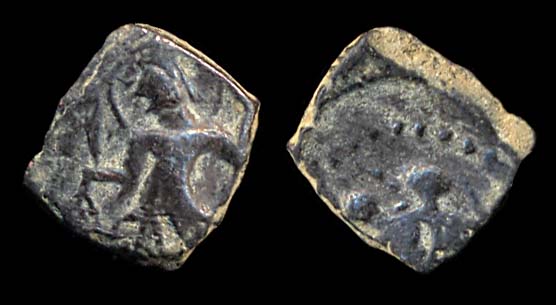 274-43. HEPHTHALITE, Gandhara, c. 5-6th c. AD, Kashmir Smast series, AE11x12 rectangular, standing king / Ardoksho seated, 1.5g, off center rev.
274-43. HEPHTHALITE, Gandhara, c. 5-6th c. AD, Kashmir Smast series, AE11x12 rectangular, standing king / Ardoksho seated, 1.5g, off center rev.Image may be NSFW.
Clik here to view.
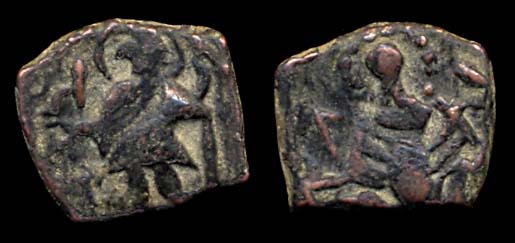 274-44. HEPHTHALITE, Gandhara, c. 5-6th c. AD, Kashmir Smast series, AE11x12 rectangular, standing king / Ardoksho seated, 1.7g
274-44. HEPHTHALITE, Gandhara, c. 5-6th c. AD, Kashmir Smast series, AE11x12 rectangular, standing king / Ardoksho seated, 1.7gImage may be NSFW.
Clik here to view.
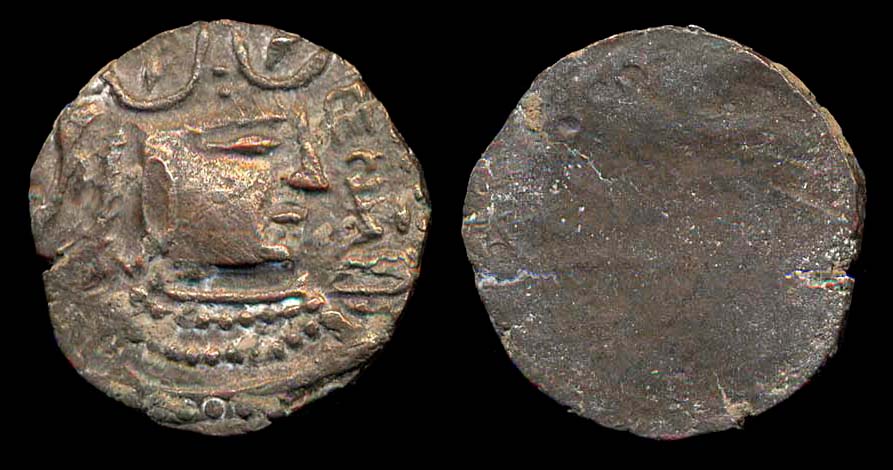 HEPHTHALITE, GANDHARA, "Narendra," c. 570-600 AD, billon drachm, 21mm, 4.1g, MA-nl, "Gidrifi" style bust R / trace of design, "Narendra" fully written, very unusual with anything on reverse
HEPHTHALITE, GANDHARA, "Narendra," c. 570-600 AD, billon drachm, 21mm, 4.1g, MA-nl, "Gidrifi" style bust R / trace of design, "Narendra" fully written, very unusual with anything on reverse Image may be NSFW.
Clik here to view.
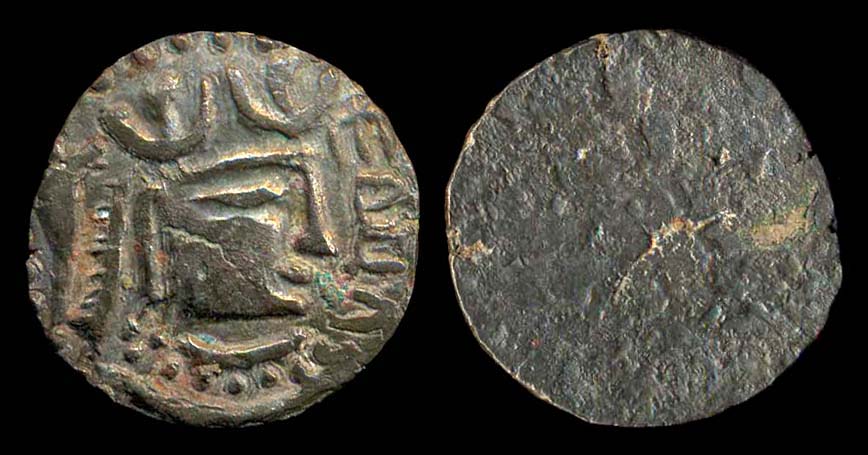 HEPHTHALITE, GANDHARA, "Narendra," c. 570-600 AD, billon drachm, MA-nl, "Gidrifi" style bust R / blank
HEPHTHALITE, GANDHARA, "Narendra," c. 570-600 AD, billon drachm, MA-nl, "Gidrifi" style bust R / blank***A hoard of these camoe out in late 2007. I know of at least 75 pieces. My guy told me that's all there are but I don't believe it. Such assurances are pretty much never true. So immediately the price is $100 less than it used to be. How low will they go? Only the Shadow knows. And note that I call the bust style "Gidrifi," which is the nickname of the type put out by the Abbasids few centuries later. Probably the Gidrifis should really be nicknamed "Narendroid."
Image may be NSFW.
Clik here to view.
 HEPHTHALITE, Gandhara, "Narendra," c. 570-600 AD, billon drachm, 22mm, 6g, bust R / blank, "Narendra" fully written
HEPHTHALITE, Gandhara, "Narendra," c. 570-600 AD, billon drachm, 22mm, 6g, bust R / blank, "Narendra" fully writtenImage may be NSFW.
Clik here to view.
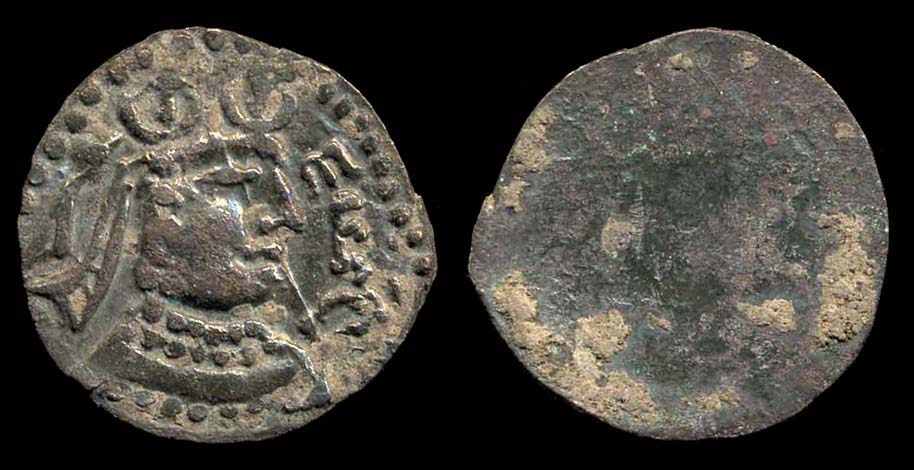 HEPHTHALITE, Gandhara, "Narendra," c. 570-600 AD, billon drachm, 22mm, 6g, bust R / blank, "Narendra" fully written, 22mm, 6.5g
HEPHTHALITE, Gandhara, "Narendra," c. 570-600 AD, billon drachm, 22mm, 6g, bust R / blank, "Narendra" fully written, 22mm, 6.5gImage may be NSFW.
Clik here to view.
 269-92. HEPHTHALITE, Gandhara, "Narendra," c. 570-600 AD, billon drachm, 5.5g, MA-nl, bust R / blank, "Narendra" fully written, slight porosity
269-92. HEPHTHALITE, Gandhara, "Narendra," c. 570-600 AD, billon drachm, 5.5g, MA-nl, bust R / blank, "Narendra" fully written, slight porosity Image may be NSFW.
Clik here to view.
 269-93. HEPHTHALITE, Gandhara, "Narendra," c. 570-600 AD, billon drachm, 6.5g, MA-nl, bust R / blank, "Narendra" barbarously written
269-93. HEPHTHALITE, Gandhara, "Narendra," c. 570-600 AD, billon drachm, 6.5g, MA-nl, bust R / blank, "Narendra" barbarously writtenImage may be NSFW.
Clik here to view.
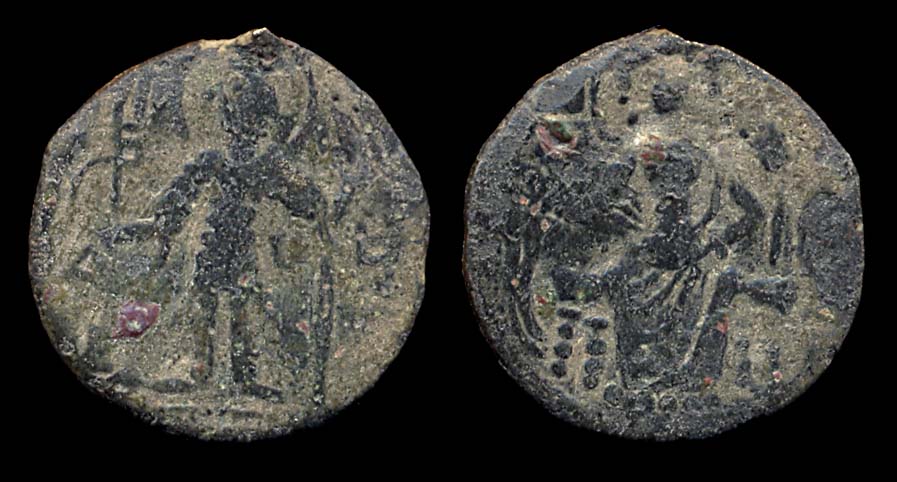 276-83. HEPHTHALITE, NW PAKISTAN, Mihiragula, c. 515-530 AD, copper stater, MA-3779v, haloed king standing / Ardoksho seated facing, 4.5g,
276-83. HEPHTHALITE, NW PAKISTAN, Mihiragula, c. 515-530 AD, copper stater, MA-3779v, haloed king standing / Ardoksho seated facing, 4.5g, Image may be NSFW.
Clik here to view.
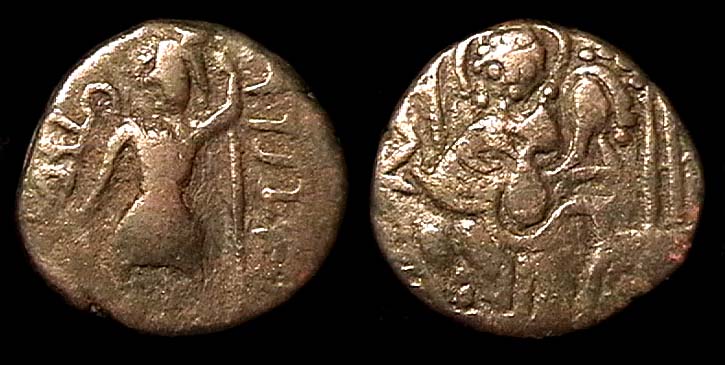 HEPHTHALITE, NW PAKISTAN, Mihiragula, c. 515-530 AD, 21mm copper stater, king standing / Ardoksho seated facing
HEPHTHALITE, NW PAKISTAN, Mihiragula, c. 515-530 AD, 21mm copper stater, king standing / Ardoksho seated facingImage may be NSFW.
Clik here to view.
 HEPHTHALITE, c. 590-610, silver drachm, MA-nl, imitation of Sasanian Hormazd IV, BHL year 11, countermarked tamgha obv. & FORO in cursive Greek rev., shallow obv die, sketchy obv. c/m,
HEPHTHALITE, c. 590-610, silver drachm, MA-nl, imitation of Sasanian Hormazd IV, BHL year 11, countermarked tamgha obv. & FORO in cursive Greek rev., shallow obv die, sketchy obv. c/m, http://www.anythinganywhere.com/commerce/coins/coinpics/indi-heph.htm
वैश्रवण mf(ई)n. relating or belonging to कुबेर MBh.; m. (fr. वि-श्रवण ; cf. g. शिवा*दि) a patr. (esp. of कुबेर and रावण) AV. &c
Image may be NSFW.
Clik here to view.

INDIA, ALCHON HUNS, Shahi Vaisravana Silver drachm, Göbl 139
| Obverse | Bust of king right, trident (tamgha?) at right, three-headed snake at left, Brahmi legend above: Shahi ... Vaisravanasya | |
| Reverse | Fire altar, with armed attendants standing left and right, obliterated as usual for these coins | |
| Date | c. 5th century CE | |
| Weight | 3.57 gm. | |
24 mm. (Diameter)
|
Image may be NSFW.
Clik here to view.![Ancient Coins - INDIA, ALCHON HUNS, Shahi Vaisravana Silver drachm, Göbl 139, VERY RARE & CHOICE!]()
INDIA, ALCHON HUNS, Anonymous post-Mehama Silver drachm, Göbl 70 |
Image may be NSFW.
Clik here to view.![Ancient Coins - INDIA, ALCHON HUNS, Anonymous post-Mehama Silver drachm, Göbl 70. Fine style type. VERY RARE and CHOICE!]()
Clik here to view.

| Obverse | Bust of king with "fly-whisk" shoulder ornaments right, tamgha at left, medallion or sun wheel at right, Bactrian legend above: shoyo alchono |
| Reverse | Fire altar, with armed attendants standing left and right, mostly obliterated as usual for these coins |
| Date | c. 5th century CE |
| Weight | 3.53 gm. |
| Diameter | 29 mm. |
| Die axis | 3 o'clock |
Göbl had assigned this type to Khingila. Vondrovec assigns it to an anonymous "Shao Alchono" but continues to group it with the coins of Khingila. However, stylistic considerations make it quite clear that this type follows the coins of Mehama. And just as Mehama's coins come in a fine style and a crude style, this type also comes in fine and crude styles. |
INDIA, ALCHON HUNS, Javukha Silver drachm, Göbl 51
Image may be NSFW.
Clik here to view.![Ancient Coins - INDIA, ALCHON HUNS, Javukha Silver drachm, Göbl 51. SCARCE & CHOICE!]()
Clik here to view.

| Obverse | Bust of king right, wearing crescent-crested crown, small tamgha at left, Brahmi legend above, at left: Shahi, at right: Jaookha |
| Reverse | Fire altar, with armed attendants standing left and right, obliterated as usual for these coins |
| Date | c. 5th century CE |
| Weight | 3.44 gm. |
| Diameter | 30 mm. |
| Die axis | ? |
| Reference | Göbl Hunnen 51, MAC 1435-36 |
| Comments | Probably issued in Taxila. Note the elongated head typical of these Huns who practiced head binding. |
INDIA, ALCHON HUNS in Kashmir, Anonymous Base Silver drachm
Image may be NSFW.
Clik here to view.![Ancient Coins - INDIA, ALCHON HUNS in Kashmir, Anonymous Base Silver drachm, SCARCE and CHOICE!]()
Clik here to view.

| Obverse | Bust of king right, wearing crown topped with two crescents with stars inside them, Brahmi legend at right: jayatu, all within dotted border |
| Reverse | Blank |
| Date | c. 6th century CE |
| Weight | 4.07 gm. |
| Diameter | 21 mm. |
| Die axis | n.a. |
| Reference | Vondrovec, type 321 (p. 382) https://www.vcoins.com/en/stores/coinindia/36/product/india_alchon_huns_in_kashmir_anonymous_base_silver_drachm_scarce_and_choice/1027688/Default.aspx |
INDIA, ALCHON HUNS, Mehama Silver drachm, Crude style type, Göbl 74
Image may be NSFW.
Clik here to view.![Ancient Coins - INDIA, ALCHON HUNS, Mehama Silver drachm, Crude style type, Göbl 74. SCARCE and CHOICE!]()
Clik here to view.

| Obverse | Bust of king right, tamgha at right, blundered Brahmi legend above: mapama |
| Reverse | Fire altar, armed attendants standing left and right, mostly obliterated as usual for these coins |
| Date | c. late 5th century CE |
| Weight | 3.00 gm. |
| Diameter | 30 mm. |
| Die axis | 3 o'clock |
| Reference | Göbl Hunnen 74 |
| Comments | Mehama is a king whose identity has become clear only within the last 10 years or so, with the publication, in 2006, of the Schøyen Copper Scroll inscription by Gudrun Melzer. We now have several newly discovered coin types for this king, including this coin and a type in gold as well. He was clearly an important king, whose history is still being discovered. Göbl had published a few coins of this king (type 74), which were of crude style, such as this one. Göbl read the legend on them as mapama and assigned them to Khingila. But we are now able to assign these coins to Mehama. |
INDIA, ALCHON HUNS or HEPHTHALITES, Silver drachm imitating Peroz
Image may be NSFW.
Clik here to view.![Ancient Coins - INDIA, ALCHON HUNS or HEPHTHALITES, Silver drachm imitating Peroz.]()
Clik here to view.

| Obverse | Bust of the Sasanian king Peroz right, wearing winged head-dress, blundered Pahlavi legend at right, all within ruled border with hash-marks surrounded by three crescent moon ornaments and with the Hephthalite bull head-dress above |
| Reverse | Fire altar, with attendants standing left and right, sun and moon above |
| Date | c. late 6th century CE |
| Weight | 3.92 gm. |
| Diameter | 30 mm. |
| Die axis | 4 o'clock |
| Reference | MAC 1453, Göbl Hunnen 263 https://www.vcoins.com/en/stores/coinindia/36/product/india_alchon_huns_or_hephthalites_silver_drachm_imitating_peroz/921907/Default.aspx |
HEPHTHALITES, NEZAK HUNS: Shahi Tegin (Tigin) of Khorasan Billon drachm
Image may be NSFW.
Clik here to view.![Ancient Coins - HEPHTHALITES, NEZAK HUNS: Shahi Tegin (Tigin) of Khorasan Billon drachm, SCARCE!]()
Clik here to view.

| Obverse | Bust of king right, wearing elaborate crown, Bactrian legend at right: Tegin, King of Khorasan |
| Reverse | Fire altar flanked by two attendants, Bactrian legend: sri shayo, year 480 |
| Date | c. 702-703 |
| Weight | 2.25 gm. |
| Diameter | 23 mm. |
| Die axis | 12 o'clock |
| Reference | Göbl Hunnen 240, Vondrovec Type 240 (p. 651), MAC 1554 https://www.vcoins.com/en/stores/coinindia/36/product/hephthalites_nezak_huns_shahi_tegin_tigin_of_khorasan_billon_drachm_scarce/1027689/Default.aspx |
HEPHTHALITES, NEZAK HUNS: Shahi Tegin (Tigin) of Khorasan AR drachm
Image may be NSFW.
Clik here to view.![Ancient Coins - HEPHTHALITES, NEZAK HUNS: Shahi Tegin (Tigin) of Khorasan AR drachm, SCARCE!]()
Clik here to view.

| Obverse | Bust of king three-quarters right, crown with two trident-like elements and a lion (panther?) head on top, Bactrian legend at right: sri shaho, Brahmi legend around: sri hitivira kharalava paramesvara sri shahi tiginadeva karita (Iltabar of Khalaj, devotee of the lord, the lord Tegin had made this [coin]) |
| Reverse | Bust of divinity facing, with flaming hair, Pahlavi legend around, naming Tegin, King of Khorasan, year 77. Göbl identifies this deity as Anahita, Vondrovec as Adur. |
| Date | c. 728 |
| Weight | 2.14 gm. |
| Diameter | 29 mm. |
| Die axis | 10 o'clock |
| Reference | Göbl Hunnen 208, Vondrovec Type 208 (p. 656) https://www.vcoins.com/en/stores/coinindia/36/product/hephthalites_nezak_huns_shahi_tegin_tigin_of_khorasan_ar_drachm_scarce/994419/Default.aspx |
Hephthalites
HEPHTHALITES (Arabic Hayṭāl, pl. Hayāṭela), a people who formed apparently the second wave of “Hunnish” tribal invaders to impinge on the Iranian and Indian worlds from the mid-fourth century C.E. The first invaders, known simply as “Huns” (see CHIONITES), representing Gk. *Xίων “Hun” plus tribal suffix -itai, were reported by the Latin historian Ammianus Marcellinus (16.9.3-4) as engaged in hostilities on the northeast frontier of Iran with the Sasanian Šāpūr II in 356. Subsequently, around 380 C.E., a certain Kidara emerges in Ḵorāsān with the Sasanian title of Kušānšāh “King over the Kushans,” his name appearing in Greco-Bactrian script on Kushano-Sasanian type gold coins as Kidaro. Later drachms, showing a younger portrait, give the name Kidara in Brahmi script, suggesting a successor of the same name. Thus the dominant confederacy of Hunnish tribes became known as Kidarites, evidently designating a political, rather than an ethnic, grouping. Hunnish incursions into Iran in the time of Bahrām V Gōr (420-38) and of Yazdegerd II (438-57) may also have involved the Kidarites (see SĀSĀNIAN DYNASTY). However, when Priscus, describing events under the Sasanian king Pērōz (457-84), repeatedly mentions the “Kidarite Huns” under a king “Kounchas” [Kunḵās] (ed. Bornmann, pp. 95, 97-98, 106; tr. Blockley, pp. 337, 347, 355, 361), his usage is probably anachronistic, since Procopius (Persian Wars 1.3.1-7), in his classic account of these Huns, attributes the same role to the (H)Ephthalite Huns. The latter, also known as White Huns, he describes as entirely distinct from the other Huns and as dwelling close to the Persian border, where their center is a city named Gorgo. This name is usually interpreted as referring to the medieval Jorjān, near the present Gonbad-e Qābus (q.v.). However, there is a Persian eyewitness account reported by the Armenian historian Lazar describing the wars of Pērōz with the Hephthalites, his disastrous defeat and death, and the extent of the conquest of the eastern borderland. It says: “a few men escaped the slaughter; reaching Vrkan they told every one of these grievous events” (tr. Thomson, 1991, pp. 214-15). It thus appears that the Hephthalites did not reach Gorgān, and the reference may rather be to Gorgānj/Jorjāniya in Choresmia.
Procopius claims that the Hephthalites live in a prosperous territory, are the only Huns with fair complexions, do not live as nomads, acknowledge a single king, observe a well-regulated constitution, and behave justly towards neighboring states. He also describes the burial of their nobles in tumuli, accompanied by the boon-companions who had been their retainers in their lifetimes; this practice contrasts with evidence of cremation among the Chionites in Ammianus (19.2.1: post incensum corporis . . .) and with remains found by excavators for the European Huns and remains in some deposits ascribed to the Chionites in Central Asia. It is therefore assumed that the Hephthalites constituted a second Hunnish wave who entered Bactria early in the fifth century C.E., and who seem to have driven the Kidarites into Gandhara.
The campaigns of the Sasanian Pērōz against the Heph-thalites are widely reported in the Islamic sources; they are also mentioned by Joshua the Stylite (Luther, 1997, pp. 109-14), as well as described by Lazar. Apparently Pērōz launched three campaigns against these Huns, all disastrous: in the first being led to a waterless desert and forced to surrender, and in the third charging to his death in a concealed ditch with all his cavalry. His coin series tends to confirm this version, depicting the king with three different successive crowns, thus implying two separate restorations. Ṭabari, who reports these events (I, p. 873; tr., V, p. 110), claims that hostility between Pērōz and the Hephthalites was aggravated by reason of their practice of sodomy, an allegation found also in Balāḏori (Fotuhá, p. 403) and in Balʿami’s expanded Persian translation of Ṭabari (ed. Bahār, p. 955). These events are also narrated by Ṯaʾālebi and by Moḥammad ʿAwfi, Jawāmeʿ al-Ḥekāyāt (apud Niẓámu’d-dín, pp. 148, 168). The fullest account of the defeats of Pērōz is probably that of the Šāh-nāma (ed. Moscow, VIII, pp. 12-17; tr. Warner and Warner, VII, pp. 165-69), where the Hephthalite king is reported as Ḵošnavāz (so also in Balʿami), while the Arabic sources record the name as Aḵšonvār (q.v).
Thereafter the Hephthalites exercised undisputed control of an extensive territory in Central Asia, Ḵorāsān, and Afghanistan. When Kawād (488-96) succeeded in Iran, he was deposed and imprisoned; but he escaped, and, benefiting from his acquaintance with the Hephthalites, amongst whom he had lived as a hostage after the defeat of Pērōz, obtained the help of their ruler and a military contingent, enabling him to recover the Sasanian throne. A large indemnity in coin had also been paid by Pērōz, after his various defeats, and Kawād no doubt also had to pay the Hephthalites substantially for his restoration. It was only with the rebuilding of Sasanian power under Ḵosrow I Anoširvān, between A.D. 558 and 561, when the Persians acted in concert with the newly-arrived Turkish horde under their Khāqān Sinjibu (Silzaboulos, with variants, in Byzantine sources), that the two powers were finally able to crush the Hephthalites in an epic battle near Bukhara, dividing their territories along the line of the Oxus (Amu Daryā). The Šāh-nāma names the defeated Hephthalite king Ḡātfar (ed. Moscow, VIII, p. 157), though in Ṭabari (I, p. 895) he appears as Warāz (variant Wazar). Yet, though the power of the Hephthalites was destroyed in Transoxania, Hephthalite kingdoms remained in Afghanistan, of which fragments survived for some time even after the Arab invasions.
It is not entirely clear what relationship had existed between these Hephthalite principalities in Transoxania and those which grew up in Afghanistan and impinged on the kingdoms of India. These last may have derived from the Central Asian Hunnish states, but more probably were separate and independent. Indian sources do not distinguish precisely between the Kidarites and the Hephthalites, designating the invader merely as Huṇas, though there are allusions to the Śveta Huṇa “White Huns” (evidently the Hephthalites). There is also possible mention of “Red Huns” and “Black Huns” (Bailey, 1954). The Gupta emperor Kumāragupta in his final year, 454-55 C.E., faced a Hunnish invasion, which was repelled by his crown prince Skandagupta, who then succeeded, but had to encounter several later attacks, with varied success.
Around 510 C.E., a Hephthalite ruler Toramāṇa established his power over much of northern and western India. He was succeeded in about 525 by his son, Mihirakula, whose ferocity and cruelty became legendary. The latter is mentioned in inscriptions of his fifteenth year at Gwalior and also at Mandasor. According to the last he was eventually defeated and captured by Yaśodarman, and apparently succeeded by his uncle or brother (?) Hiraṇyakula. However, he was finally released, and he re-established his power in Kashmir, where he survived until about 540 C. E. He is said to have derived entertainment from having elephants driven over the precipices there and listening to the squeals of the terrified animals as they fell. Succeeding rulers of the Hephthalite kingdom seem to have been based in Afghanistan, though whether in Kabul, Bamiyan (Bāmiān), Gardez, or, most probably, Ghazni, is uncertain. From the coin series, and brief notices in the Kashmir chronicle Rājataraṅgiṇī (which seems, however, to be affected by some chronological disarrangement), we learn of other rulers, Lakhana Udayāditya and Khiṅgala Narendrāditya, and the latest king, known only by his honorific title Purvāditya, whose demise could have taken place shortly before 600 C.E. The epoch of the Hephthalites seems to have seen a striking revival of accomplished sculpture in Afghanistan, this time using marble, and with a preference for Brahmanical subjects. A marble image of the Hindu deity Gaṇeśa, reputedly found at Gardez, was dated in the eighth year of Khiṇgala (Sarcar, 1963). It is linked to the horrific painting of a Hephthalite king at the cave of the 53-meter Buddha in Bamiyan by the fact that in the painting the adjoining figure of a prince wears a jewel in the form of a bull’s head, seen also on marble sculptures related to the Gaṇeśa image (Bivar, in press).
Subsequently, in the seventh century, among opponents of the Arab invaders is included, in north and northwestern Afghanistan, a personage named by Arab historians Tarkhān Nēzak, to whom are now plausibly attributed the many coins read by older numismatists as Npky MLKʾ, better understood as Nyzky MLKʾ(Nēzak Šāh; see NĒZAK). In Arachosia coins are known of a seventh-century ruler called in Pahlavi Tkyn ḥwlʾsʾn MLKʾ (Tegin Ḵorāsān Šāh), probably identical with the personage named by Biruni as Varhategin, a founder of what that author calls the “Turkish” dynasty. Yet although this name indeed suggests a Turkish origin, both these survivors may have represented Hephthalite remnants. The Tegin Ḵorāsān Šāh was probably the founder of Teginābād, a city on or near the site of present-day Kandahār. A tribal element with a claim to Hephthalite descent was the medieval Ḵalaj (q.v.). There are indications that sections of this group were originally Turkish-speaking, though federated in the earlier Middle Ages with Pashto-speaking tribes. It is also claimed that the tribe of the Gurjaras accompanied the Hephthalite invaders, giving their name to various localities on their route to Gujarat, and that they are ancestral also to the Gujar pastoralists who today frequent the higher elevations of the North-West Frontier Province and Kashmir.
The newly-discovered Bactrian documents studied by N. Sims-Williams (1997, 2001) throw interesting light on Afghanistan during the Kushano-Sasanian and Hephthalite periods, containing references to a tax collected specially as tribute for the Hephthalites (Sims-Williams, 1997, No. 16). Under them, a surprisingly orderly administration is shown to have been carried on, thereby substantiating the report of Procopius above. These documents make clear that the Middle Iranian Bactrian language written in Greek script was not the native idiom of the Hephthalites, as some have claimed, but the traditional language of administration in this region from Kushan times and possibly earlier. There is, as mentioned above, some evidence of the use of Turkish language under the Hephthalites. The name Mihirakula possibly represents a Sanskritization of a Turkish designation mihr-qul“slave of Mithra,” a familiar theophoric formation. The Bactrian documents also attest several Turkish royal titles, though these could also be explained by later Turkish infiltration south of the Oxus.
Bibliography:
ʿAwfi, Muḥammad, in M. Niẓámu’d-dín, Introduction to the Jawámiʿ ul-Ḥikáyát wa Lawá-miʿu ʾRiwáyát of Sadídu’d-dín Muḥammad al-ʿAwfí, London, 1929. (The full text of the relevant passages seems not yet to be printed.)
H. W. Bailey, “Hāra-hūṇa,” Asiatica.Festschrift Friedrich Weller, Leipzig, 1954, pp. 12-21.
M. K. Dhavalikar, “A note on two Gaṇeśa statues from Afghanistan,” East and West21, 1971, pp. 331-36.
Firdausi, The Sháhnáma of Firdausi, tr. by Arthur George Warner and Edmond Warner, vol. VII, London, 1915.
R. Ghirshman, Les Chionites-Hephthalites, Cairo, 1948.
R. Göbl, Dokumente zur Geschichte der Iranischen Hunnen in Baktrien und Indien, Wiesbaden, 1967, 4 vols. Vol. III provides a comprehensive album of the Hephthalite and related coinages, but the text volumes should be read with caution.
Frantz Grenet, “Regional interaction in Central Asia and Northwest India in the Kidarite and Hephthalite periods,” Proceedings of the British Academy 116, 2002, pp. 203-24.
S. Kuwayama, “The Turki-Shāhis and relevant Brahmanical sculptures in Afghanistan,” East and West, 26/3-4, 1976, pp. 375-407.
Idem, “L’Inscription du Gaṇeśa de Gardez et la chronologie des Turki-Śahis, JA 279, 1991, pp. 267-87.
B. A. Litvinsky, “The Hephthalite Empire” in B. A. Litvinsky et al., eds., History of the Civilizations of Central Asia, III: The crossroads of civilizations: A.D. 250-750, Paris, 1996, pp. 135-62.
Andreas Luther, tr., Die syrische Chronik des Josua Stylites, Berlin, 1997.
W. M. McGovern, The early empires of Central Asia, Chapel Hill, 1939; repr. Raleigh, 1965, p. 408.
A. Miller, Accounts of the Western Nations in the history of the Northern Chou dynasty, Berkeley, 1959, esp. pp. 11-12.
Priscus, ed. Fritz Bornmann, Prisci Panitae Fragmenta, Firenze, 1979; English tr. by R. C. Blockley, Fragmentary Classicizing historians of the later Roman Empire, II, Liverpool, 1983. Nicholas Sims-Williams, Bactrian documents from Northern Afghanistan: the decipherment of Bactrian, London, SOAS, 1997 (esp. no. 16 hbodalo iabgo . . . hbodalo co(ad)hoaggo labiro “Hephthalite yabghu . . . scribe of the Hephthalite lords.”
Idem, Bactrian documents from Northern Afghanistan. I. Legal and economic documents (Studies in the Khalili Collection of Islamic Art, Volume III), Oxford, 2001; = Corpus Inscr. Iran., Pt. II. Inscriptions of the Seleucid and Parthian periods and of Eastern Iran and Central Asia. Vol. VI. (esp. Glossary, p. 193, s.v. hbodologgo adj. “Hephthalite;” hbodalo noun “Hephthalite,” etc.).
D. C. Sircar, “Three early medieval inscriptions: 1. Kabul inscription of Shāhi Khingāla,” Epigraphia Indica 35, 1963, pp. 44-47.
This is probably the most reliable edition, but the editor was under the misapprehension that the title Shāhi, ordinary Middle Persian designation for “King,” necessarily implies a connection with the ninth-century C.E. dynasty of the Hindu-Shahis and their immediate predecessors. His dating of the letter-forms as sixth-seventh century C.E. is more convincing. Donald Stadtner, “Two fifth-century Bodhisattvas from Afghanistan,” South Asian Studies 16, 2000, pp. 37-44.
M. A. Stein, ed., Kalhana’s Rajatarangini or Chronicle of the Kings of Kashmir. I. Sanskrit Text with Critical Notes, Bombay, 1892; repr. New Delhi, 1989.
Idem, tr., Kalhana’s Rajatarangini: A Chronicle of the Kings of Kashmir, Translated, With an Introduction, Commentary, & Appendices, 2 vols., Westminster, 1900; repr. Delhi, 1979.
Idem, “White Huns and kindred tribes in the history of the Indian North West Frontier,” Indian Antiquary 34, 1905, pp. 74-85.
Robert W. Thomson, tr., The History of Lazar P’arpec’i, Atlanta, 1991.
G. Tucci, “Preliminary report on an archaeological survey in Swat,” East and West 9/4, December 1958, pp. 276-328.
The inscription of Khiṇgala is summarily edited on pp. 327-28, n. 29.
Geo Widengren, “Xosrau Anoširvan, les Hephthalites et les peuples Turcs,” Orientalia Suecana 1, 1952, pp. 69-94.
(A. D. H. Bivar)
Originally Published: December 15, 2003
Last Updated: March 22, 2012
This article is available in print.
vol. XII, Fasc. 2, pp. 198-201
vol. XII, Fasc. 2, pp. 198-201
The Hephthalites of Central Asia – by Richard Heli
A Western student's first encounter with the mysterious Ephthalites, or Hephthalites, or White Huns of Central Asia, is probably via the writings of Procopius, that contemporary of the Byzantine Emperor Justinian and fierce polemicist against his sovereign and the Empress Theodora. Procopius recorded the observations of an ambassador traveling east with Byzantium's sometime enemies, the Persians, who had chosen for a time, and from the Byzantine perspective very fortunately, to war against their eastern neighbors for a change, the Ephthalites: "The Ephthalites are of the stock of the Huns in fact as well as in name; however they do not mingle with any of the Huns known to us.... They are the only ones among the Huns who have white bodies and countenances which are not ugly." [Procopius]
Thus, even in their very first appearance, the question of the origins of this people comes into doubt. For if they are Huns, how is it that the appearance of these "White Huns" differs so markedly from that of the Huns proper? This question was not one which Procopius, so far from the Ephthalites, was in any position to determine. That modern researchers can do better is largely due to the survival of writings on the other end of the Central Asian wasteland, by those who were closer to the point of origin and encountered this group early in its history, that is, the Chinese.
To the Chinese, they were the Ye-ti-i-li-do or Yeda, even though the Chinese chroniclers seem to realize that the people called themselves the people of Hua (the similarity to Hun may help explain the origin of "White Hun") and that the Chinese terms came actually from the name of the Hua leader. Like Procopius, contemporary Chinese chroniclers had their own theories about Ephthalite origins. One thought that were related in some way to the Visha (Indo-Europeans known to the Chinese as the "Yueh Chih" (Yuezhi)), another, a branch of the Kao-ch`ê, a third, descendants of the general Pahua, a fourth descendants of Kang Chu and a fifth admits that he cannot make clear their origins at all. This should not discourage as it is not in the theories of such writers that we may find value, but rather in their factual observations which may lead to the answer.
Japanese researcher Kazuo Enoki takes on the theories of both the ancient and the modern writers, including the redoubtable Stein, knocking the legs out from one after another. Theories which are based on coincidence of name, e.g. Pahua and Hua, are unlikely in this part of the world which exhibits so many languages and so much linguistic adaptation and orthographic variation, he points out, and should not be upheld if other sorts of evidence do not support the reasoning. Stein's contention that the Ephthalites were of the Hunnish tribe and therefore of Turkish origin is dismissed largely on this basis. On the other hand, J. Marquart finds similarities between the terms for the Ephthalites in India and words in the Mongolian language, but this theory requires so many leaps between tongues that it remains quite unconvincing. Finally, there is a whole school of researchers attempting to prove this tribe a Turkish, albeit non-Hun, one. These too must rely only on flimsy name evidence. Instead, Enoki makes a convincing case that the Ephthalites are actually an Iranian group. His theory, it must be admitted, does not explain all, but there seems little against it. More importantly, it relies first on data which is generally agreed upon, namely, ancient observations of Ephthalite geographical movements and culture.
For Enoki, Ephthalite origins may be determined by considering where they were not, as well as by where their conquests drove their enemies. They were not previously north of the Tien Shan, thus they did not stem from that region. They drove the Kidarites out of Balkh to the west, thus they came originally from the east. By such reasoning, the Ephthalites are thought to have originated at Hsi-mo-ta-lo (southwest of Badakhshan and near the Hindu Kush), which tantalizingly, stands for Himtala, "snow plain", which may be the Sanskritized form of Hephthal.
Turning to the elements of Ephthalite culture, Enoki notes that Procopius' comments on their appearance while not decisive, are in favor of an Iranian theory. Similarly, the seventh century travels of Hsuan Chwang show that he found no physical difference between the descendants of the Ephthalites and their known Iranian neighbors. As for their language, commentators made clear that it was neither Turkish nor Mongol, which also seems to support an Iranian origin.
Iranian customs also are common in the Ephthalite world. For example, the practice of several husbands to one wife, or polyandry, was always the rule, which is agreed on by all commentators. That this was plain was evidenced by the custom among the women of wearing a hat containing a number of horns, one for each of the subsequent husbands, all of whom were also brothers to the husband. Indeed, if a husband had no natural brothers, he would adopt another man to be his brother so that he would be allowed to marry. Conjugal rights were traded off and children were assigned in turn with the oldest husband receiving the first and so on. Tellingly, polyandry has never been associated with any Hun tribe, but is known of several Central Asian ones, including the Aryans in India, other Indo-Europeans and probably in prehistoric Iran.
In their religious beliefs, the Ephthalites are said to have worshipped fire and sun gods. While either one is not unusual in any early culture around the world, both together is likely to indicate a Persian origin. In Persia, such beliefs were later to culminate in Zoroastrianism.
As part of their religious observance, the Ephthalites did not cremate, but as is reported by all commentators including Procopius, always buried their dead, either by constructing a tomb or under the ground. This is not consistent with the Zoroastrian practice of leaving the body in the open, but is clearly at odds with Turkish nomadic groups. The practice of inhumation then may simply indicate an Iranian group which had been sundered from the main branch at an early date and had adopted local Central Asian burial customs.
The rocketlike political career of the Ephthalites may be traced in Appendix A. It may be seen that its enormous rapid successes came not only out of ferocity in battle, but also from shrewd diplomacy. Like the Arabs, the Vikings and others in the parade of history, they seem to appear virtually out of nowhere and amass for themselves a huge area. Of their language, only four words are known including "Ephthalite" itself, and these dubious. Their coins are putative at best, their arts, wholly unknown.
Despite their apparent talents for war and diplomacy, however, they appear to have been harsh rulers disliked by rebellious subjects and thus their legacy is brief. Persian Emperor Chosroes, faced with the choice of war against the Turks or conquest of the Ephthalites, hardly needed a moment to opt for the latter -- ironic if the Ephthalites truly had an Iranian origin. But such nationalistic ideas were not the rule in those times. Not much has been written about their dramatic story since 1966, but Enoki hints that from the translation and study of possible Ephthalite documents unearthed at Lou Lan, we may someday learn more about this mysterious and fascinating people. Let us hope it will be so.
Appendix A: Approximate Timeline. [Enoki, McGovern]
Richard Heli
February 19, 1996
Richard Heli
Thus, even in their very first appearance, the question of the origins of this people comes into doubt. For if they are Huns, how is it that the appearance of these "White Huns" differs so markedly from that of the Huns proper? This question was not one which Procopius, so far from the Ephthalites, was in any position to determine. That modern researchers can do better is largely due to the survival of writings on the other end of the Central Asian wasteland, by those who were closer to the point of origin and encountered this group early in its history, that is, the Chinese.
To the Chinese, they were the Ye-ti-i-li-do or Yeda, even though the Chinese chroniclers seem to realize that the people called themselves the people of Hua (the similarity to Hun may help explain the origin of "White Hun") and that the Chinese terms came actually from the name of the Hua leader. Like Procopius, contemporary Chinese chroniclers had their own theories about Ephthalite origins. One thought that were related in some way to the Visha (Indo-Europeans known to the Chinese as the "Yueh Chih" (Yuezhi)), another, a branch of the Kao-ch`ê, a third, descendants of the general Pahua, a fourth descendants of Kang Chu and a fifth admits that he cannot make clear their origins at all. This should not discourage as it is not in the theories of such writers that we may find value, but rather in their factual observations which may lead to the answer.
Japanese researcher Kazuo Enoki takes on the theories of both the ancient and the modern writers, including the redoubtable Stein, knocking the legs out from one after another. Theories which are based on coincidence of name, e.g. Pahua and Hua, are unlikely in this part of the world which exhibits so many languages and so much linguistic adaptation and orthographic variation, he points out, and should not be upheld if other sorts of evidence do not support the reasoning. Stein's contention that the Ephthalites were of the Hunnish tribe and therefore of Turkish origin is dismissed largely on this basis. On the other hand, J. Marquart finds similarities between the terms for the Ephthalites in India and words in the Mongolian language, but this theory requires so many leaps between tongues that it remains quite unconvincing. Finally, there is a whole school of researchers attempting to prove this tribe a Turkish, albeit non-Hun, one. These too must rely only on flimsy name evidence. Instead, Enoki makes a convincing case that the Ephthalites are actually an Iranian group. His theory, it must be admitted, does not explain all, but there seems little against it. More importantly, it relies first on data which is generally agreed upon, namely, ancient observations of Ephthalite geographical movements and culture.
For Enoki, Ephthalite origins may be determined by considering where they were not, as well as by where their conquests drove their enemies. They were not previously north of the Tien Shan, thus they did not stem from that region. They drove the Kidarites out of Balkh to the west, thus they came originally from the east. By such reasoning, the Ephthalites are thought to have originated at Hsi-mo-ta-lo (southwest of Badakhshan and near the Hindu Kush), which tantalizingly, stands for Himtala, "snow plain", which may be the Sanskritized form of Hephthal.
Turning to the elements of Ephthalite culture, Enoki notes that Procopius' comments on their appearance while not decisive, are in favor of an Iranian theory. Similarly, the seventh century travels of Hsuan Chwang show that he found no physical difference between the descendants of the Ephthalites and their known Iranian neighbors. As for their language, commentators made clear that it was neither Turkish nor Mongol, which also seems to support an Iranian origin.
Iranian customs also are common in the Ephthalite world. For example, the practice of several husbands to one wife, or polyandry, was always the rule, which is agreed on by all commentators. That this was plain was evidenced by the custom among the women of wearing a hat containing a number of horns, one for each of the subsequent husbands, all of whom were also brothers to the husband. Indeed, if a husband had no natural brothers, he would adopt another man to be his brother so that he would be allowed to marry. Conjugal rights were traded off and children were assigned in turn with the oldest husband receiving the first and so on. Tellingly, polyandry has never been associated with any Hun tribe, but is known of several Central Asian ones, including the Aryans in India, other Indo-Europeans and probably in prehistoric Iran.
In their religious beliefs, the Ephthalites are said to have worshipped fire and sun gods. While either one is not unusual in any early culture around the world, both together is likely to indicate a Persian origin. In Persia, such beliefs were later to culminate in Zoroastrianism.
As part of their religious observance, the Ephthalites did not cremate, but as is reported by all commentators including Procopius, always buried their dead, either by constructing a tomb or under the ground. This is not consistent with the Zoroastrian practice of leaving the body in the open, but is clearly at odds with Turkish nomadic groups. The practice of inhumation then may simply indicate an Iranian group which had been sundered from the main branch at an early date and had adopted local Central Asian burial customs.
The rocketlike political career of the Ephthalites may be traced in Appendix A. It may be seen that its enormous rapid successes came not only out of ferocity in battle, but also from shrewd diplomacy. Like the Arabs, the Vikings and others in the parade of history, they seem to appear virtually out of nowhere and amass for themselves a huge area. Of their language, only four words are known including "Ephthalite" itself, and these dubious. Their coins are putative at best, their arts, wholly unknown.
Despite their apparent talents for war and diplomacy, however, they appear to have been harsh rulers disliked by rebellious subjects and thus their legacy is brief. Persian Emperor Chosroes, faced with the choice of war against the Turks or conquest of the Ephthalites, hardly needed a moment to opt for the latter -- ironic if the Ephthalites truly had an Iranian origin. But such nationalistic ideas were not the rule in those times. Not much has been written about their dramatic story since 1966, but Enoki hints that from the translation and study of possible Ephthalite documents unearthed at Lou Lan, we may someday learn more about this mysterious and fascinating people. Let us hope it will be so.
Appendix A: Approximate Timeline. [Enoki, McGovern]
| 420-427 | Ephthalites raid Persia as far west as modern Tehran. |
| 427 | Ephthalites suffer overwhelming defeat in Persia. |
| 437 | Chinese embassy to Tokharistan (area around Balkh) and Gandhara finds no sign of Ephthalites. |
| 454 | Ephthalites revenge earlier loss to Sassanid Persians. |
| 456 | Ephthalites send their first embassy to the Chinese. |
| 457 | Firuz (Peroz), former king of Persia, requests Ephthalite assistance. |
| 459 | Firuz regains Persian throne with help of Ephthalite armies. |
| 464-475 | Wars between the former allies resolved with Persian tribute in 475. |
| 465-470 | Ephthalites conquer Gandhara, set up a Tegin (a viceroy). |
| 470-480 | War between Tegin of Gandhara and Gupta Empire of India. |
| 473-479 | Ephthalites conquer Sogdiana, driving the Kidarites westwards. Next conquering Khotan and Kashgar (in the Tarim Basin). |
| 480-500 | Gupta empire collapses. Tegin is overlord of North & Central India. |
| 484 | Firuz initiates new war against the Ephthalites which fails miserably. |
| 486 | Firuz' heir Kubad takes refuge with Ephthalites following a coup. |
| 488 | Kubad regains the throne with Ephthalite assistance. |
| 493-508 | Ephthalites extend power as far as Zungaria, then Turfan and Karashar (in modern China). |
| 497 | Kubad deposed and escapes to a second refuge with the Ephthalites. |
| 500 | Ephthalites place Kubad on Sassanid throne a second time (dies 531). |
| 503-513 | Kubad makes war on the Ephthalites. Peace in 513 lasts. |
| 522 | Apex of Ephthalite power. Chief of the Juan-Juan nomads flees to the Ephthalites for protection. Ephthalites dominate north and south of the Tien Shan range. Control as far as Tieh-lo in the south, Ci`ih-le^ (Kao-ch`e^) in the north, at least to Khotan in the east probably more, and up to Persia in the west. A separate Ephthalite Empire controls much of India. Forty countries (including Sassanid Persia) are in tribute. Ephthalite centers are at Ghur, Balkh, Warwaliz (north of today's Kunduz near the source of the Oxus) and Hsi-mo-ta-lo. The entire empire probably comprises fifty to sixty thousand individuals. |
| 531 | Chosroes succeeds his father Kubad in Persia. |
| 532 | Revolts in India; Ephthalites lose most of East & Central India. |
| 532-542 | Fleeing ruler conquers the Kashmir for a short reign. |
| 552 | Turks overthrow Avars and begin petty conflicts with Ephthalites. |
| c. 565 | Turks and Chosroes (Khusrau) of Persia ally to capture and divide Ephthalite empire. |
| c. 570 | Ephthalite rule overthrown in India. |
February 19, 1996
Appendix B: Bibliography.
- Enoki, Kazuo, Memoirs of the Research Department of the Toyo Bunko, 1955, No. 18, "On the Nationality of the Ephthalites"
- Hambly, Gavin, Central Asia, 1966, Chapter 3: "Sassanians and Turks in Central Asia"
- McGovern, William, The Early Empires of Central Asia, 1939, Chap. 18: "The Huns in Persia and India," pp. 399-419, and notes, pp. 454-457.
- Procopius, History of the Wars, Books I and II, Loeb Classical Library, vol. 1, pp. 12-15
Also ...
- The White Huns play a role in Umberto Eco's new novel Baudolino
- History of the Civilizations of Central Asia, Volume III: The crossroads of civilizations: A.D. 250 to 750 (chapter 6: "The Hephthalites", pp. 135-162 by B.A. Litvinsky, Director of Oriental Studies in Moscow)
- Frye, Dr. Richard N., The Heritage of Central Asia (Hephtalites, pp. 174-9)
- The White Huns - Hephthalites (Silk Road Foundation)
- Iranian Huns
- Silk Road Exhibit (Silk Road Seattle)
- Links for the Sassanid Empire (University of Kansas)
- Timeline of Central Asia During the Tang Dynasty
- In 2006 a new article appeared: Pierfrancesco Callieri, "Hephthalites in Margiana? New Evidence from the Buddhist relics in Merv," in La Persia e l'Asia centrale da Alessandro al X secolo (Atti dei convegni Lincei, 127; Rome: Accademia nazionale dei Lincei, 1996): 391-400.
- In 2007 a paper appeared in Transoxiana, issue 12, August 2007, discussing a possible Hephthalite role at Bukhara - On the Origin of the place-Name Buxara
Richard Heli

















